
The History
1. Put the waterfalls to work!

Sam Eyde’s Vision
Founder Sam Eyde’s vision of “getting the falls to do useful work on behalf of mankind”, marked the beginning of what would become the Norsk Hydro conglomerate and an industrial adventure the like of which Norway had never seen.
Sam Eyde is considered to be the founder of both Hydro and Rjukan. He was a visionary whose ideas were momentous; he was known for declarations such as: “It’s the future we’re building!”. He harnessed the forces of nature in such a way that we can talk of a revolution – the second industrial revolution. We can easily picture him as a sort of cross between Kjell Inge Røkke and Steve Jobs, as he acquired hydroelectric power development rights and utilised the forces of the Svelgfoss and Rjukanfoss waterfalls to obtain energy for industrial production. Telemark would be transformed.
Between 1900 and 1920 the Telemark watercourse from Lake Møsvatn to Skien was the most highly developed and important in Norway. This stretch of water contains rivers and waterfalls that provided an excellent basis for hydroelectric power development. The Tinn section, which includes Møsvatn, Kalhovd, Mår, and the lakes at Tinnsjø and Heddalsvannet, forms the eastern part of the watercourse. A century later, power production here comprises almost 5 per cent of all hydroelectric power production in Norway. In the period from 1999 to 2016 the annual production of the Skien watercourse averaged 5595.45 GWh.
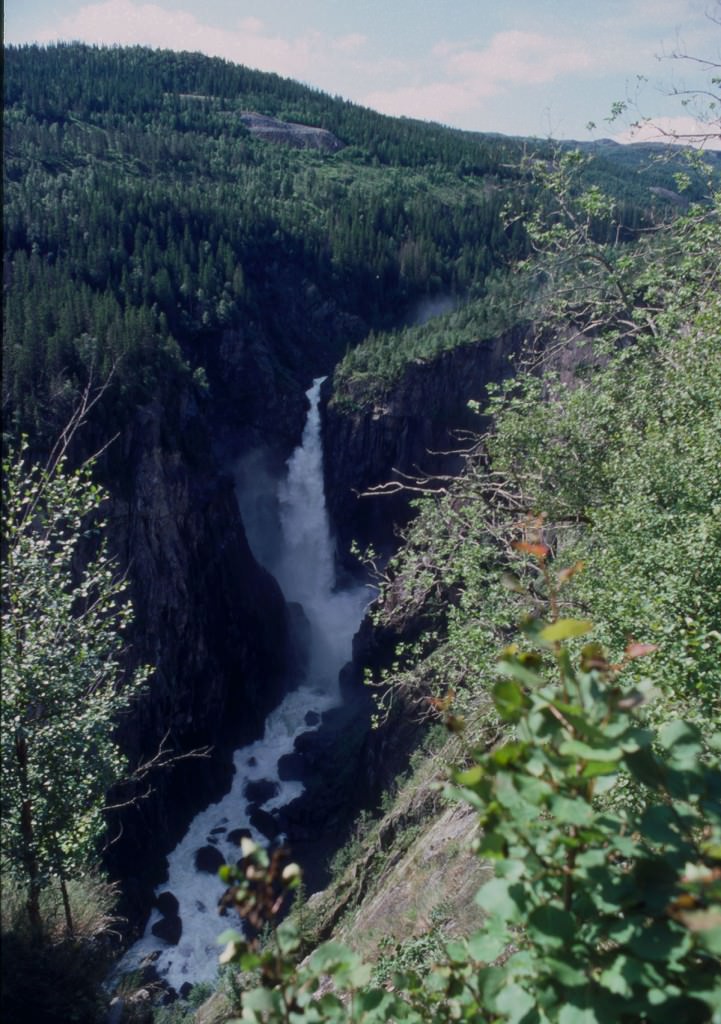
From the beginning of the twentieth century onwards, a series of hydroelectric projects were realised between Møsvatn and Notodden. Svelgfoss was the biggest in Europe when it was completed in 1907. Thereafter the way was paved for the development of Rjukanfossen, a much more extensive project. This development was carried out in a “crevice in the Hardanger plateau”.
The waterfall acquisitions completed by Sam Eyde, in conjunction with Norwegian and foreign interests, were controversial. On April 7, 1906 the Storting passed what were known as the “Panic Acts”, legislation with the intention of regulating or preventing the purchase of Norwegian waterfalls by foreign interests. In 1906 foreigners owned more than 3/4 of all the waterfalls developed by that time. New legislation was passed in 1909 and 1917 that regulated the acquisition of water systems in Norway.
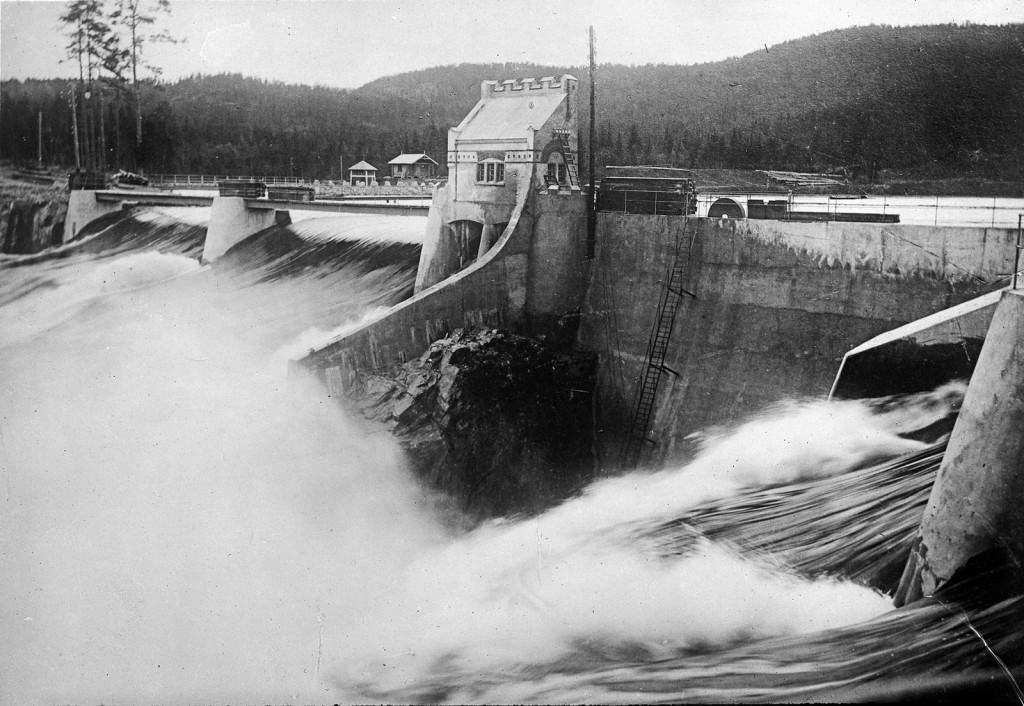
Norway was not a wealthy country as the 20th century dawned. It was therefore natural to look abroad in order to secure funding for major projects, whether hydroelectric or industrial. Between 1905 and 1920 Hydro’s investments in what is now our world heritage – Notodden and Rjukan – were equivalent to one and a half times the Norwegian state’s national budget at the time.
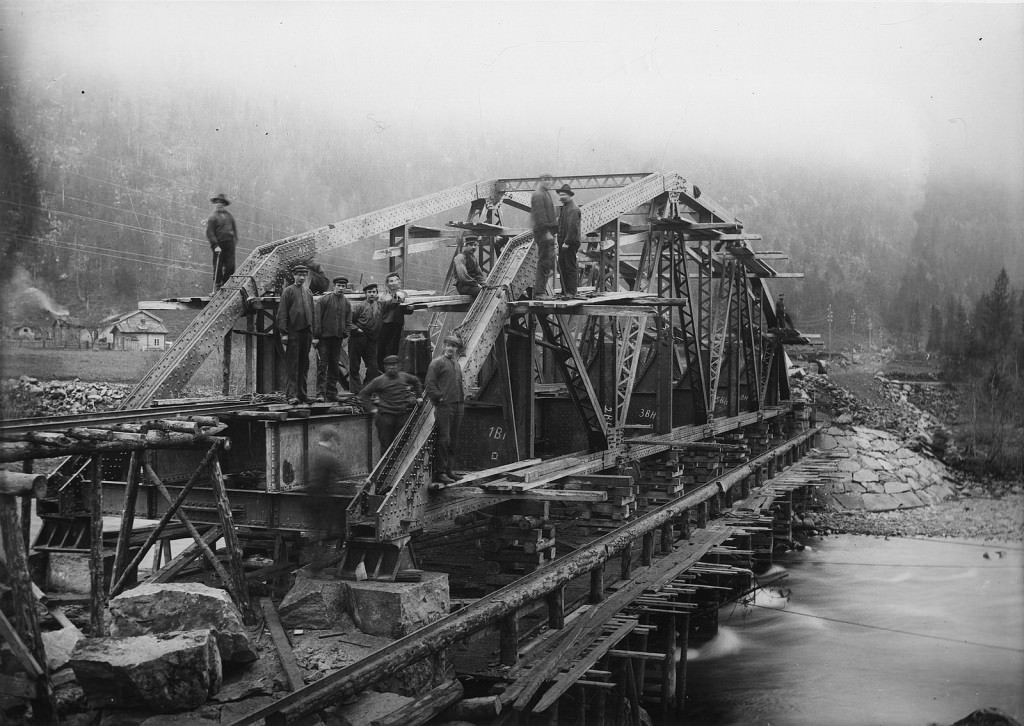
The eastern section of the Telemark watercourse – from Møsvatn to Skien – was important not only because it generated electricity, but also because of the power-intensive industry it enabled to be built.
When Såheim power station commenced operating in 1915, Hydro had an aggregate installed generator capacity of 310,000 kW. When the company a decade earlier had launched its hydroelectric power projects in Telemark, the total capacity of the entire country was only around 100,000 kW.
The first regulation of Tinnsjøen had already been carried out prior to the turn of the century, and the regulation of Møsvatn commenced in 1903. By around 1910 intensified regulation had secured a minimum inflow of water to the power stations of as much as 90 cubic metres per second.
At Notodden Tinfos operated a smaller power station from 1901 onwards. A minor expansion in 1905 also made it possible to supply power to a trial plant at Heddalsvannet lake. This was the precursor to Hydro’s first regular factory.
Before the forces of Rjukanfossen were finally tamed, no fewer than four more power projects were completed further down the watercourse. The biggest of these was Hydro’s Svelgfoss I development (1905-07).
Around the turn of the year 1905/06 work commenced on a new dam at Tinnos. The new dam was built on clay soil. It proved impossible to locate firm rock, but the dam was nevertheless sufficiently robust to remain standing for more than 90 years. The current dam at Tinnoset was built a few metres closer to the mouth.
The 1907 contract relating to the Tinnos dam also had implications for the continued regulation of Møsvatn, thus enabling a new project to be launched here from mid-July of the same year. When the factories at Notodden were completed in autumn 1907, they were able to utilise the 30,000 horsepower generated at Svelgfoss. Masts and transmission lines were erected between the power station and the factories – a stretch of 4.5 kilometres.
Subsequently a further 10,000 horsepower was supplied from the same power station, while 15,000 horsepower was provided by the development of Lienfoss, a kilometre further down the watercourse. Lienfoss, where the dam traversed the river, was an elegant construction. The Notodden factories were also able periodically to purchase power from Tinfos II (often called Borgen), which was completed in 1911.
However, the projects in the lower part of the river Tinn were gradually overshadowed by the major developments in the Møsvatn and Vestfjord valley area. They were on a scale that set a new standard for industrial and hydroelectric power development in Norway.
“It was a masterpiece in the annals of technological and labour history that they were about to create. And they certainly were apprehensive to begin with, the workers and the engineers, as they approached this gigantic task in the wild setting of the mountains. Their achievement is an outstanding chapter in the saga of waterfall development”, is how Hydro’s 50th anniversary book published in 1955 describes it.
It was initially Swedish and French capital that provided the basis for developing a new type of industry at Notodden. But when the major developments at Rjukan got underway in 1907, German participants were also involved.
The participation of the German stakeholders was secured by signing contracts for the setting up of three new companies: Norsk Kraftaktieselskab, A/S De Norske Salpeterværker and Norsk Transportaktieselskab. Sam Eyde was head of all three companies, though the Germans would supervise the running of De Norske Salpeterværkene, and a German management team was established in Kristiania. Hydro’s share capital was increased from NOK 7 to 29.6 million. Most of this capital was raised on the Paris bourse: there was scant interest in Norway. Management teams were also established here, both in Norway and in France. Work on the power plants was proceeding well, whilst there were frequent disagreements of major and minor importance when it came to the factory projects at Rjukan. One of the difficult tissues concerned the choice of technology: German Schönherr or Norwegian Birkeland-Eyde furnaces at Rjukan?
But, in the summer of 1908, cooperation with the Germans almost collapsed. Later, in the summer of 1910, a storm erupted. At extraordinary general meetings Eyde decided to stand down from his management roles at the Rjukan companies. Trials on the Schönherr furnaces had been stopped in June 1910. Yet pressure was brought to bear that resulted in Schönherr furnaces comprising 80 per cent of those installed at Rjukan I. On the other hand, all the parties were in favour of a Norwegian absorption system, based on 10-sided granite towers.
Problems continued in the autumn of 1911. Eyde then initiated fresh negotiations with both German and French stakeholders. The outcome of these was that the German contingent would be bought out, but that they would retain their NOK 5 million shareholding in Hydro. The French stakeholders had to once more raise more capital.
Many elements had to fall into place – financial, organisational, factual and formal. No less than NOK 35 million need to be raised. On October 2 1911, a board meeting could at last be held in Paris. Resolutions relating to the new structure, and that Eyde should again take overall managerial responsibility at Rjukan, were adopted at this meeting også at. Hydro was reorganised, and the acquisition of the Rjukan companies greatly transformed the company’s balance sheet, which from NOK 7.5 million in 1906 had increased to NOK 112.7 million on June 30 1913.
In the new contract Eyde promised that a fifth of Rjukan’s plants would be completed in early November 1911. Eyde travelled immediately to Rjukan and took sole command. The labour force was augmented and the men worked around the clock every day. Eyde was able to keep his promise. On November 7 smoke rose from the chimneys. There were tears of joy and celebrations at Rjukan. And just a few months later, in April 1912, the brand-new fertilizer plant was in full operation.
2. The powerplants

Muscular production
The power station Tinfos I at Notodden, which was already in operation in 1901, was the reason why Sam Eyde chose this location when seeking a site for his experimental fertilizer plant. But more power was required as larger factories were to be built. And though Svelgfoss I, Europe’s biggest power station, was ready by the autumn of 1907, it was not sufficient to meet the growing level of ambition.
Sigurd Kloumann, one of Hydro’s foremost engineers, drew up plans for the development of the Rjukanfossen waterfall which would culminate in two further power stations; firstly Vemork, and then Såheim.
Vemork was completed in the autumn of 1911, Såheim in 1915. The monumental Vemork building was the world’s biggest power station. It was designed by Olaf Nordhagen, an architect whose visions were far-reaching and on a grand scale. Såheim was also designed by Nordhagen, in conjunction with Thorvald Astrup. The coming into operation of these power stations meant that it was possible to substantially ramp up production.
Architect Olaf Nordhagen was only 24 when he designed Vemork, a 110-metre-long and 21.75-metre-wide concrete building clad in natural stone.
The use of hewn stone in the facade can probably be ascribed to Nordhagen’s insight into early Norwegian architecture, particularly church architecture. This is evident in the architectural style he employs, which features decorative mediaeval embellishments.
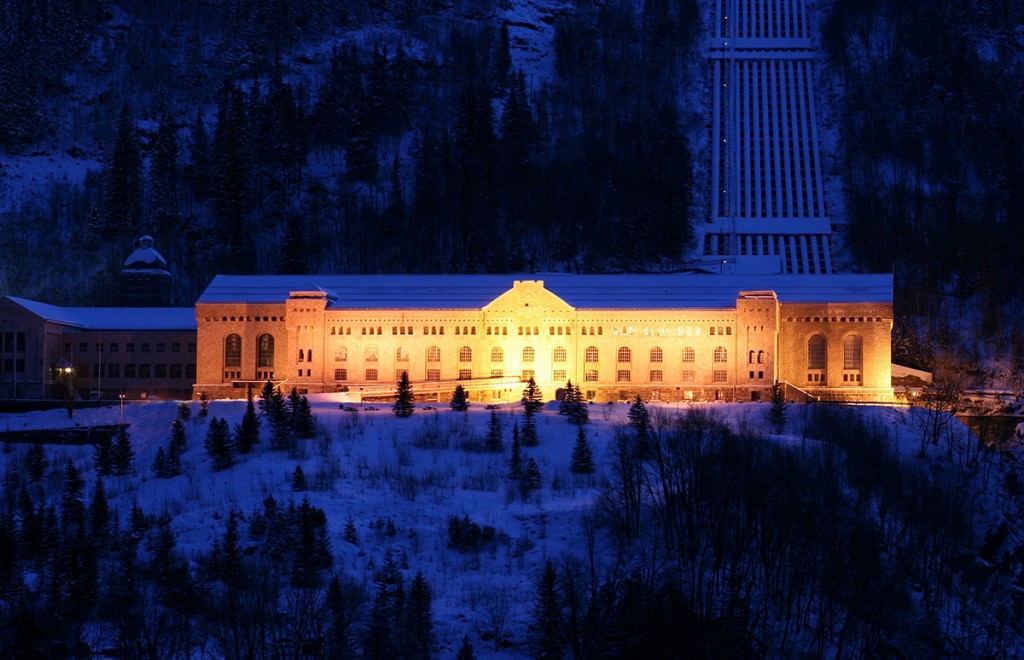
It has been said that Sam Eyde was unwilling to approve the original architectural plans, as they were when building was due to commence, because the power station had not been given the monumental design commensurate with its location. He therefore hastily summoned the young architect Olaf Nordhagen. Having seen the drawings and agreed to have a solution ready by the following afternoon, Nordhagen designed the power station. It is clear that he re-uses themes from his winning design for Bergen Library, which he produced a couple of years previously.
At Vemork two 45-tonne travelling cranes were installed, as well as 10 horizontal-axled Pelton turbines each designed for an efficiency of 76% for a maximum output of 14,500 hp. Five of the turbines were delivered by I. M. Voith, Heidenheim, and five by Escher Wyss of Zürich.
Today Old Vemork is a power station museum, but its architecture and installations provide excellent additional reasons for visiting this monumental building.
Navvies (construction workers, often itinerant) formed the labour force responsible for the construction of Vemork and Såheim, and not least the railways. Without them these projects would not have progressed at such speed, and their efforts are commemorated by monuments at both Rjukan and Notodden.
It is no coincidence that there are statues of navvies at both Rjukan and Notodden. This itinerant construction worker was one of the special features at a time when society was engaged in major transformative projects within communications, hydroelectric power and industrial development. It was the navvies who did the spadework, in both Telemark and a number of other places in Norway.
Navvies constituted a mixed group and were called many names, which they nevertheless bore with considerable pride. Some were blunt and direct, some were indeed rowdy, while others called themselves clean and honest, countering the widespread assumption that they were dirty and untrustworthy by stressing their integrity and trustworthiness. They came from near and far, their backgrounds varied considerably, but they had a lot in common. The work they did was demanding and at times dangerous; their working day was a long one, and they were often subjected to considerable pressure in order to complete the job in time. But they were intensely proud of their skills with hammer and drill, pick, spade, wheel barrow and dynamite. Their work ethics might vary somewhat, but as a rule there was a high degree of internal discipline among them. They were team players and they obeyed the instructions of their captain, the foreman, who was in turn more than a right-hand man for the engineer in charge of the project.
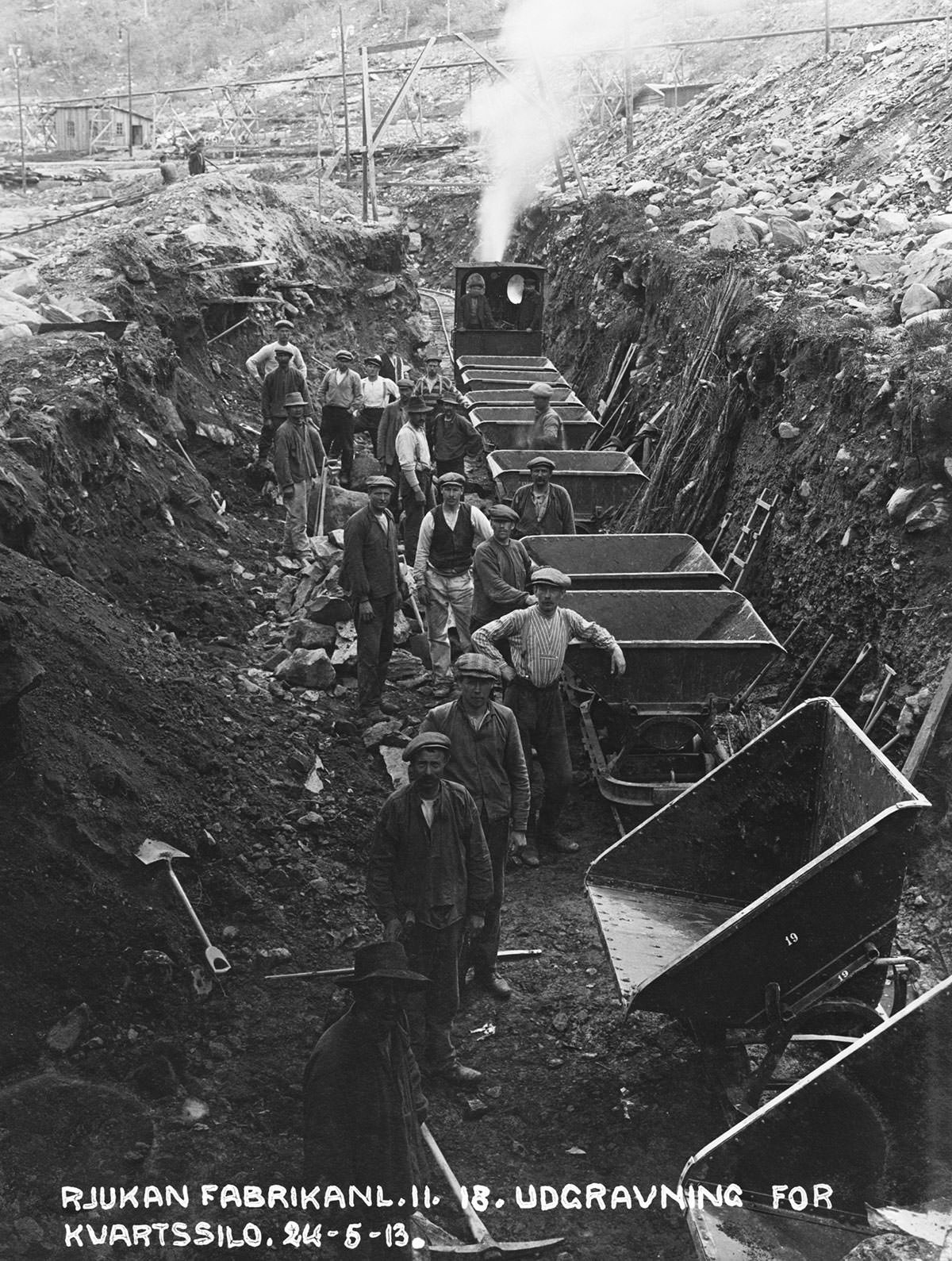
The writer Kristofer Uppdal was one of many navvies working on construction sites in Telemark, both at Notodden and Rjukan. He was engaged on the Svelgfoss project and also on the Tinnos railway. He drew on his experiences here in his literary production. Uppdal is mostly celebrated for his 10-volume work “Dance through the land of shadows”.
From 1909 onwards we find him in Rjukan. Uppdal was also struck by the monumental aspect of the industrial developments he took part in. It was amazing how it was possible to carry out such huge projects in a small place that lay off the beaten track, without proper roads, and in some extremely demanding natural surroundings.
Describing the new town that emerged in the Vestfjord valley, Uppdal wrote in 1911: “At its core stand the new and mighty factory buildings, which rest there like trolls, having grown out of the soil; first they raise their heads, then they stand halfway up and crouch there, before finally they reach their full height and totally dominate the ordinary houses around them, so that these appear like tiny dolls beside a giant.”
“He is a political reformer, who believes in the gradual social transformation of society and is supportive of the parliamentary system through thick and thin. He maintains that the labour movement can gain power that way and one day secure a majority through the ballot box. And he says this in 1918, when the countries of Europe are busy killing each other in a bloodbath that is completely without precedent….”.
Arild Bye (ed.) in “Kamp, Sakprosa i utval” H. Aschehoug & Co, (2012)
3. The Industrial adventure

From idea to action
An almost coincidental meeting on February 13 1903 between the engineer Sam Eyde and the brilliant professor Kristian Birkeland was the stroke of luck that led to the production of industrial fertilizer through the capture of atmospheric nitrogen. This represented a momentous breakthrough that enabled increased food production in Norway and other countries
The key to the industrial production of fertilizer was the invention of the electric arc furnace, which extracted nitrogen dioxide from the atmosphere for its conversion into nitric acid. This was then mixed calcium and converted into nitrate fertilizer in Hydro’s first plant at Notodden. Without industrially produced fertilizer it would not be possible currently to feed so many millions of people worldwide.
Industrial fertilizer production by means of the electric arc furnace has been declared the most important invention ever made in Norway.
The experimental plant at Notodden was destroyed by a fire in 1908, but the first electric arc furnace has been preserved. Electric arc furnaces were in operation at Notodden until 1934, and at Rjukan until 1940.
The Birkeland-Eyde process involves conducting air into a spherical furnace where an electric arc was formed between two electrodes in a powerful magnetic field. A disc-shaped flame developed in the furnace where the plasma temperature was approximately 3000 °C and the air was converted into nitrogen oxide gas: N2 + O2 → 2 NO.
Nitrogen oxide (NO) is a colourless gas, which cannot be absorbed whether it is hot or cold, and it will decompose if cooled too slowly. Rapid cooling was therefore required in order to maintain the stability of the compound. In the Birkeland-Eyde furnace the gas particles are ejected, with the aid of the flame, into the furnace’s outer air layer where they are rapidly cooled down to approximately 1000 °C. At such a temperature the molecule can remain stable.
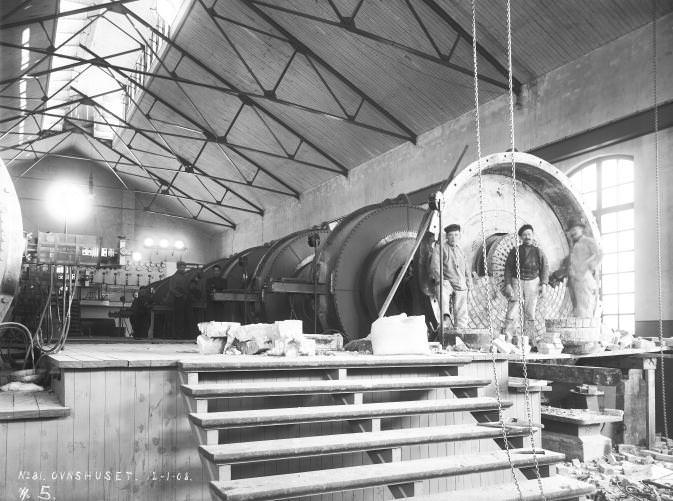
The gas is extracted by means of fans from the flues in the upper and lower sections of the furnace and then conducted through firebrick-clad ducts to be cooled down to approx. 50 °C. In the next phase the gas is introduced into a chamber where it is oxidised, using oxygen from the air in the furnace, into NO2, a brown, highly caustic gas. 2 NO + O2 → 2 NO2.
In order to produce nitric acid, the gas is absorbed by means of a reaction with water in an absorption tower. 3 NO2 + H2O → 2 HNO3 + NO. The electrodes in the electric arc furnace were made of U-shaped copper tubing, through which cooling water was conducted. The electrodes were thus enabled to burn for weeks without having to stop operations.
Foreign scientists and companies proposed that the nitric acid be mixed with water and limestone in stone or glass-built towers. This was an extremely expensive proposal; a better, and cheaper, solution was developed at Notodden – granite towers. The end-product was called Norway saltpetre and would compete on world markets with Chile saltpetre.
Two urban communities developed in step with Hydro’s development of industry in Notodden and Rjukan. Between 1907 and 1914 Hydro built 340 dwellings in both locations.
Notodden’ s first sick bay was situated in one of the first houses Hydro built in Grønnbyen. The company also built homes in Lienfoss, Villamoen, Grønnbyen, Våla and in Tinnebyen while also supporting efforts to increase the capacity of the town’s hotels and boarding houses.
At Rjukan Hydro was involved in a vast array of urban development projects: water and drainage, roads, parks, even a church and hospital. In Tinn Hydro built houses at Våer and Vemork, in Rjukan and at Mæl. Schools were built, as were a hospital and a welfare building, and buildings for provisions and administration – everything needed by the whole town.
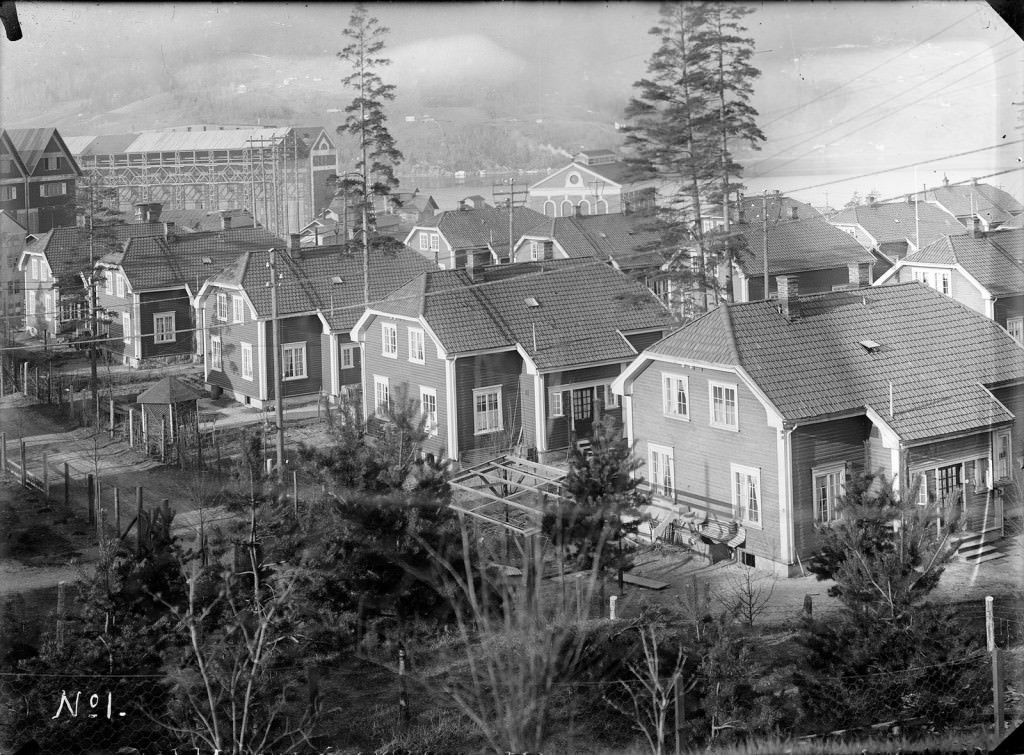
At Notodden both Hydro and the Tinfos companies played a central role in housing development. The buildings erected by both companies are characteristic of contemporary architectural styles.
Town planning along the lines of the garden city concept pioneered in the UK and Germany can be seen in both Notodden and Rjukan. Experience gained in Notodden proved to be useful when planning Rjukan, where a more robust planning organisation devoted its attention to the water and drainage system at an early stage. Some of the same architects were involved in both towns.
When the plants at Notodden were completed in 1907, the local population had already surpassed 2,000. The 6,000 mark was reached just a few years later, and in 1913 the place was awarded town status. Many people sought to come here – whether to work on the construction sites, or in the factories, or in the service industries that followed in the wake of industrialisation.
But for a long time, a lack of housing was an urgent problem. It is reported that workers had to sleep out in the open and that others chose to leave again, even though there were jobs available. Many managed to rent a bed or a room, while having to eat their meals in the town’s cafés.
“Notodden is the Nordic Klondike. Mushroom-like, it has grown very rapidly and is therefore still too unsettled to be considered a proper town”, wrote the newspaper Socialdemokraten on December 5 1908.
Rjukan can be said to have been built as a company town. People there would say: “Tell me what sort of job you have, and I’ll tell you where you live”.
In its early phase, the embryonic Rjukan society was dominated by the construction workers consisting of large numbers of young men. As at Notodden, there were at times some wild outbreaks of fighting and drunkenness. But these turbulent early times passed over into a more peaceful and predictable period as the urban society in the Vestfjord valley matured. Families were started, or moved in; father went to work, the children went to school, and mother ran the household. Mothers in the working-class families sewed clothes, patched trousers and darned socks. The better-off could buy clothes and avail themselves of the services of the town’s seamstresses.
Many achieved a standard of living that was previously unheard of, with running water and electricity, garbage disposal and postal deliveries. In the afternoons there were often queues at the newsagents, as people were not content simply to read a local paper, they also wanted to keep up-to-date with what was happening elsewhere in Norway as well as abroad. In many ways an advanced urban society had come into being, one which was forward-looking and representative of the new industrial society of the 20th century. Despite sharp class differences, inner tensions and considerable differences in living standards, the people of Rjukan developed a pride in what they had helped to create and what they were now taking care of collectively.
The efforts of the workers at Notodden and Rjukan achieved the 8-hour day into in 1918 and just one year later it became the standard working day for the whole country.
The plight of workers during the First World War was difficult. Food prices increased rapidly and wages were falling behind. The workers were exhausted and voices were frequently raised declaring the necessity of using muscle to back the claim for an 8-hour day.
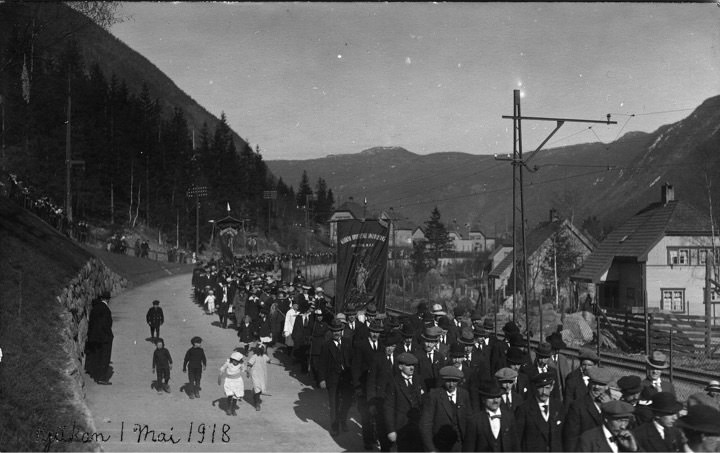
In 1918 the time had come. At Notodden 2000 marched in the May 1 procession under the slogan:” We demand an 8-hour day!” A meeting was held that resulted in a resolution for a law to be passed with immediate effect establishing the 8-hour day. Afterwards ten trade union leaders convened and decided all would work eight hours from the following day. On May 2 the factory whistle at Hydro sounded two hours after everyone had gone home. The same happened soon afterwards at the Rjukan plants.
An industrial tribunal imposed an injunction that the wage agreement be followed, but this was not complied with. At the same time the employer’s federation began to negotiate with a delegation from Notodden and Rjukan. They reached agreement on a 51-hour working week pending a government proposal on the matter.
Two of the union leaders also approached Prime Minister Gunnar Knudsen seeking a pledge for an early amendment to the law. This was enacted in the summer of 1919. The ten union leaders from Notodden were sentenced by an industrial tribunal to pay a fine of NOK 10 each for inciting the masses. This was a mild reaction, and the fines were apparently never paid.
Fertilizers are all about food and producing enough of it. It has always been a question of food, of having enough food to live and to survive; the struggle for one’s daily bread. Much has changed over ten thousand years, over a thousand years, and over a hundred years – but the struggle continues.
The development of agriculture has brought the biggest change to mankind’s way of life. And it is scarcely controversial to maintain that agriculture will also be of decisive significance in the foreseeable future. The history of mankind tells us that agricultural development, which provided a certain degree of food supply security, was a precondition for the emergence of more advanced civilisations. But history also tells us of an uncertain and faltering balance between food requirements and the production of food.
Mankind has all along suffered from an endless series of famines in the wake of breakdowns in the supply of food. The causes of these breakdowns have been numerous: crop failures, plant disease, wars and other man-made tragedies. History has taught us that predictability – or a certain surplus of food – can insure against serious incidents being exacerbated thorough food supply disruptions.
As people began to settle in the one place and became dependent on the growth of the soil, they soon learned that not only do plants need water, they also require nutrition in order to produce good yields. The nutrients that are extracted from the earth need to be replenished if yields are not to decrease. Neither the soil nor growing conditions are the same everywhere; nor are the climatic and topographical features. It is hardly surprising, then, that agriculture became a science many generations ago.
What is the actual composition of nutrients in the soil? What are the different functions of nutrients such as nitrogen, phosphate, potassium, calcium, sulphur, magnesium, iron, boron, manganese, zinc, copper etc? von Liebig’s law of the minimum states that if one of the nutrients is lacking, a plant’s growth will be held back, even though all the other nutrients are present. If this deficiency is remedied, plant growth will increase until another nutrient becomes the limiting factor. The role of fertilization is to help achieve an optimal yield and secure a nutritional balance in the soil.
The creativity of man and his thirst for knowledge have been and is considerable. It was both handy and sensible to use decaying plant remains and dung from domestic animals. It was not quite so handy, but it also made sense to use bird droppings – guano – that had to be transported from South America. Sales of the latter were enormous, but it provided neither a lasting nor a secure answer to the problem.
Other types of industrially produced fertilizers have a long history too. At the beginning of the 20th century, the nitrogenous gases formed during the carbonisation of coal provided the most important basis for the production of ammonia (NH3). Ammonium sulphate was produced in countries which had major coal industries. However, there was concern that a lack of nitrogen fertilizer would create serious problems for agriculture and food supply.
It is against this background that Birkeland and Eyde’s electric arc furnace (1905) emerges as a scientific breakthrough. The inventors knew it was possible to fix atmospheric nitrogen in an industrially produced fertilizer product. They also knew that the additional yields produced by their new product – Norway saltpetre – were formidable! A success history from Norway that also provided a considerable impetus to scientific researchers and industrial specialists in a number of other countries. Industrially produced fertilizer made it possible to increase food production worldwide and substantially boost food security.
The development of new and improved fertilizer products took place in conjunction with soil sample taking, mechanisation, larger units, improved plant properties, and increased efficiency at every stage.
The challenge is to be able feed a constantly growing global population. Both nationally and globally we need to produce food in such a way that utilises available resources in the best possible way. More specifically it is a question of animal husbandry, of what is grown on which fields, of water resources, plant protection products, fertilizers, of runoff and emissions.
Agriculture in many parts of the world has changed radically during the past 50-60 years. Food production has more or less tripled in this period, when the global population has more than doubled. The interplay between the so-called green revolution and the use of industrially manufactured plant nutrition explain much of the increased agricultural production.
In 2017 the world’s population was estimated to have reached 7.5 billion; it is expected to climb to 9 billion by 2050. Will this development cause problems? What opportunities do we have? Some facts are incontestable: access to new agricultural acreage is limited, while climate considerations, and the goal of a more sustainable agriculture, provide strong arguments for protecting our remaining areas of forest and wetlands.
The status in 2018 is that modern agriculture is crucial for our food supply. Without mineral fertilizer total agricultural production would be roughly 50 per cent less than what is actually is.
Forecasts suggest that the most important task is to utilise better, and produce more, on the acreages that are already in use or which can be made available for agriculture. For the fertilizer industry it is obvious that it must define its role within the framework of overarching national and global policies.
Yara, which has its roots back with Birkeland and Eyde, believes that the climate footprint of food production can be reduced by more than 50 per cent by continuously improving the way in which agriculture is conducted. Some of the challenges facing us can be solved through the mineral fertilizer production process and by the cooperation between the industry and the farming community in order to promote best practice.
4. Rjukan

From village to town
In the early 1900s a completely new industrial community was built at Rjukan. By harnessing the immense power of the Rjukanfoss waterfall electricity could be generated, and the newly emergent industries required a lot of it.
In just ten years the Saaheim district in the Vestfjord valley was transformed from a small village into a town of more than 10,000 people – a modern urban community, with water and drainage facilities, electric lighting and a telephone system.
Talented architects were deliberately sought to design the industrial complexes and powers stations and to plan the new urban communities. Although many of them were still young, they were confident of being able to meet demanding challenges in a convincing way.
Several of the architects who came to Notodden were also assigned commissions at Rjukan, some of them simultaneously, others subsequently. From June 1 1908 the Byanlegget at Rjukan, or town planning board, was in operation (also referred to in German as the “Architektführung”). An architect named Levin was its first manager. Besides the industrial buildings, the architects were responsible for the design of schools, welfare buildings, the post office, pharmacy and dwellings for the blue- and white-collar workers.
When BASF of Germany sold its stake in 1911, the architectural office was closed and Hydro established a town planning board (Rjukan Byanlegg). Erling Gjestland headed the office from 1911, followed by Hjalmar Waaden (1914-1916) and Jens Poulsson (1916-1934).
Other well-known personalities employed in the design planning and construction of Rjukan were: the engineers Lars Broch and Hjalmar Steffens, and architects Olaf Nordhagen, Thorvald Astrup, Magnus Poulsson, Ove Bang, B. Keyser Frölich, Christian Morgenstierne, Harald Aars, Joh. E. Nilsen, Bjarne Blom, Helge E. Blix.
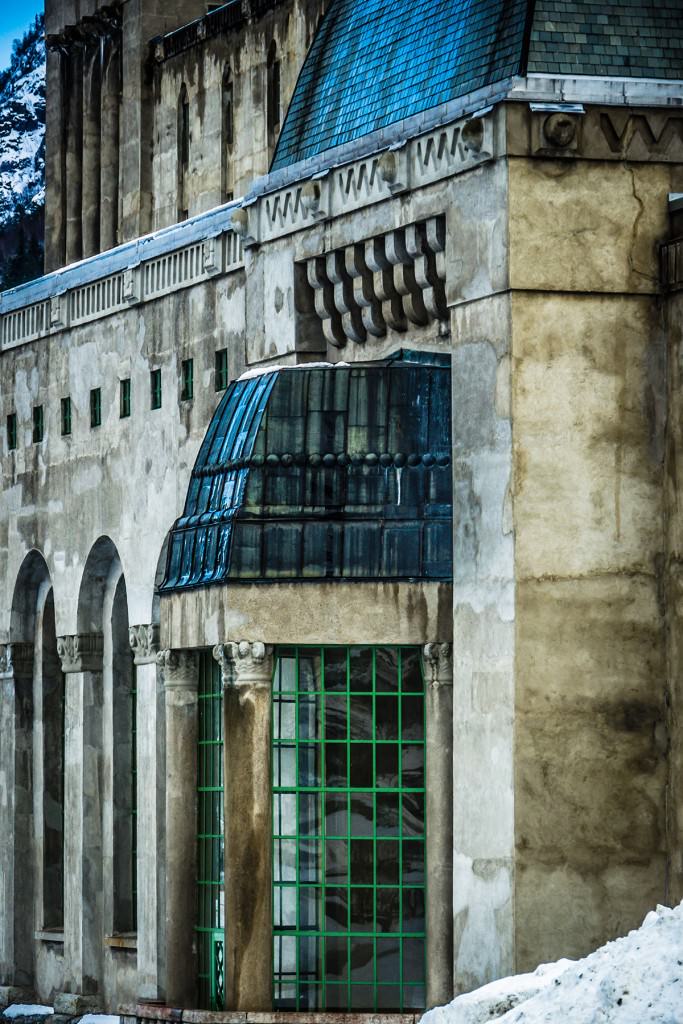
The class divide was evident in Rjukan. The executive directors, senior staff and other local leaders lived in Villaveien, which caught the most sunshine. Further down in the town were Flekkebyen and Egne hjem, where the workers’ houses were situated.
Those who poured into the Vestfjord valley in search of work felt deprived of their rights and experienced a lack of amenities right from the start. They were subject to whatever inclinations suited the industrialists and they had to put up with the resultant conditions. As soon as a project was completed, they might find themselves out of work again. As Professor Helge Dahl describes it: “Even in this Klondike several hundred people went without food or a roof over their heads. Starving, half-naked, shivering and freezing they trudged from one hut to another, grateful for the smallest crumbs that fell from their better-off workmates’ tables.”
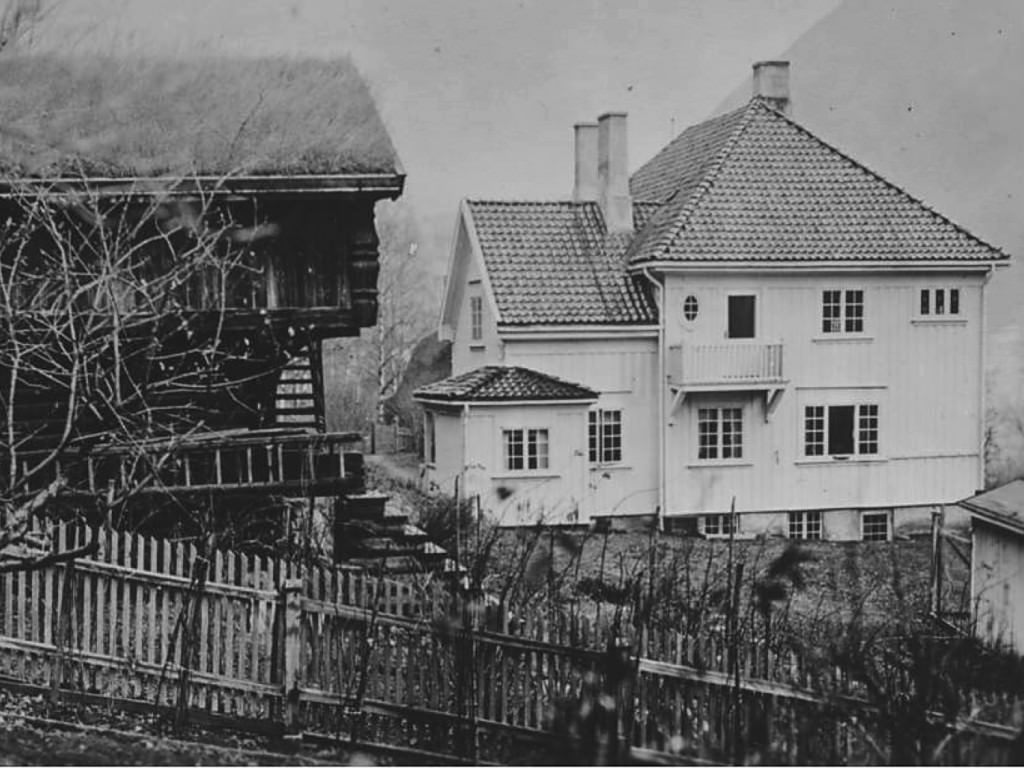
At Rjukan the navvy Kristofer Uppdal declared that emancipation and social change had to come first. Art would have to take second place, he believed – a construction worker who penned short stories and novels in the evenings and at night.
However, it would not be long before workers in Rjukan had time and energies for more than union activities and the struggle for material conditions. But they lacked places where they could meet. Meetings were held in tunnels, huts and cafés. Then one day, in November 1908, workers were asked to leave Arnesen’s refectory hut because guests were expected. That’s when a mason named Watz hammered his fist into the table and exclaimed: “Let’s build a place of our own!” And that’s exactly what the workers did – they built a place where they could meet. And not just one, but two.
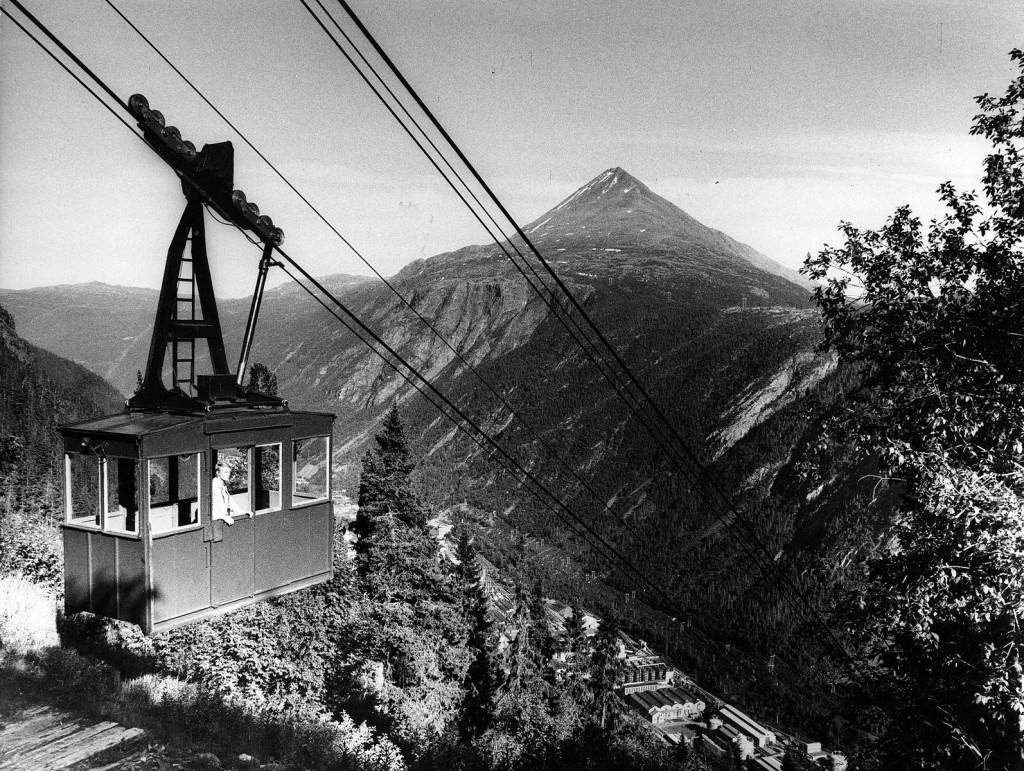
The Krosso cable car was a gift from Hydro to the people of Rjukan. It enabled them to get up into the mountains and enjoy some sunshine in the winter months.
The Krosso cable car operates today and a trip on it offers you a spectacular view, a mountain-top restaurant, and an excellent starting-point for treks into the Hardanger plateau.
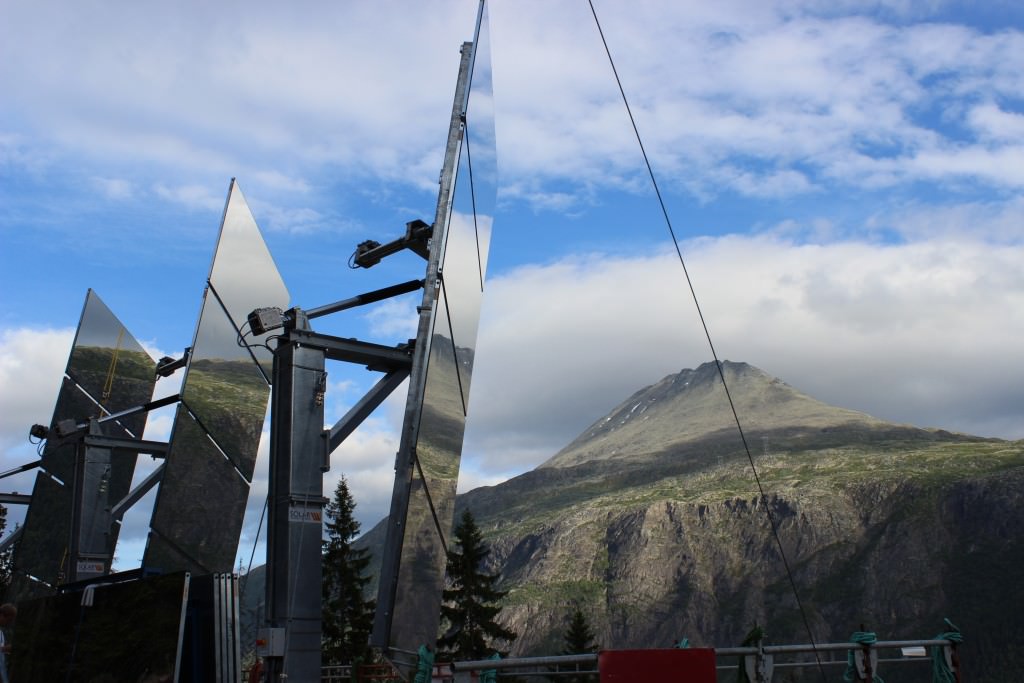
The idea of a mirror that would reflect the sun down into the valley during the winter months, was conceived by Sam Eyde og Oscar Kittelsen back in 1913. The mountains surrounding Rjukan are so steep that no sun penetrates the valley during the winter. But at that time, they did not possess the technology to implement their concept. It would take 100 years before the mirrors literally saw the light of day. The sun mirrors can today be enjoyed in all their glory in the town square.
Rjukan underwent some tremendous changes in the early years of the 20th century. These pictures were taken just nine years apart, in 1907 and 1916.
The focus on those urban features that are contained within the World Heritage’s boundaries is on locations and buildings that particularly represent or typify Rjukan. The town of Rjukan is unique in a Norwegian context as it is the first totally planned town built under the auspices of a private company.
As a major construction development, it does have clear role models abroad; it is the Norwegian equivalent to the Swedish mining town of Kiruna, where under LKABs ‘s direction a prestigious housing programme was carried out by “a majority of Sweden’s foremost architects, artists, technicians etc…” with the backing of the Wallenbergs’ capital.
A planned town
Rjukan town planning board was also responsible for the first industrial buildings in the Vestfjord valley. This meant that the development of Rjukan was planned and implemented in a much more integrated way than was the case for Notodden, although to begin with this was a rural community of about 400 people. In the course of the decade leading up to 1915, there emerged a town of 10 000 inhabitants. This was hardly possible without some problems, and they did crop up in most areas. In the negotiations with BASF and the French stakeholders, insufficient emphasis was given to the fact that an urban society had to be developed practically from scratch if industrial plants were to be built in the same location as the large power stations in the Vestfjord valley.
Despite some problems underway, their remained enthusiastic and all pulled together to complete their task. And on May 1 1910 they were able to inaugurate the People’s House in Skriugata. In February 1912 a cinema was installed there, and in the same year the trade unions also purchased a neighbouring building. They had therefore secured suitable premises for their union and political activities. The People’s House also became a centre for cultural pursuits and entertainment; there was room for musical groups, dancing classes, theatre productions and, in time, a library as well.
In 1917 the position of full-time librarian was advertised and Henrik J. Hjartøy was appointed. He was to play a decisive role in developing the People’s Library at Rjukan to become a solid, popular and significant institution in the young town – a real cultural centre. Hjartøy travelled to Oslo and abroad to purchase literature that he considered important. The library, which had a comprehensive stock of books, had one particular speciality: the ideology, history and leading personalities of the labour movement. It became known as the “Red Library” and in 1924 relocated to suitable premises in a new building under municipal management.
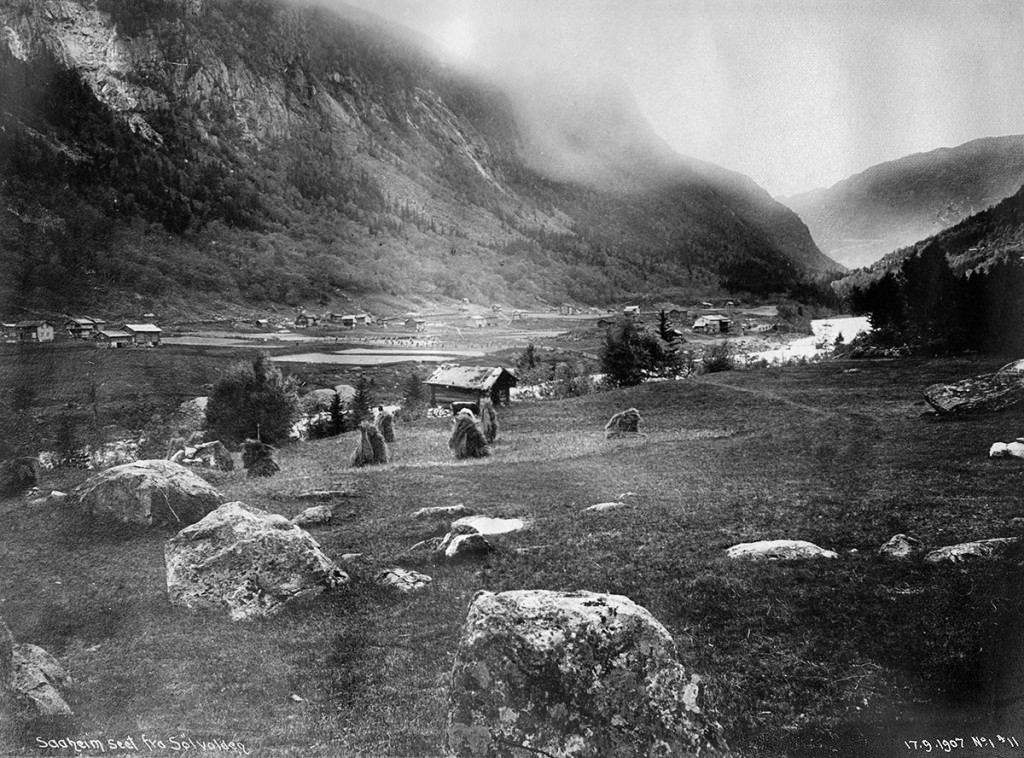
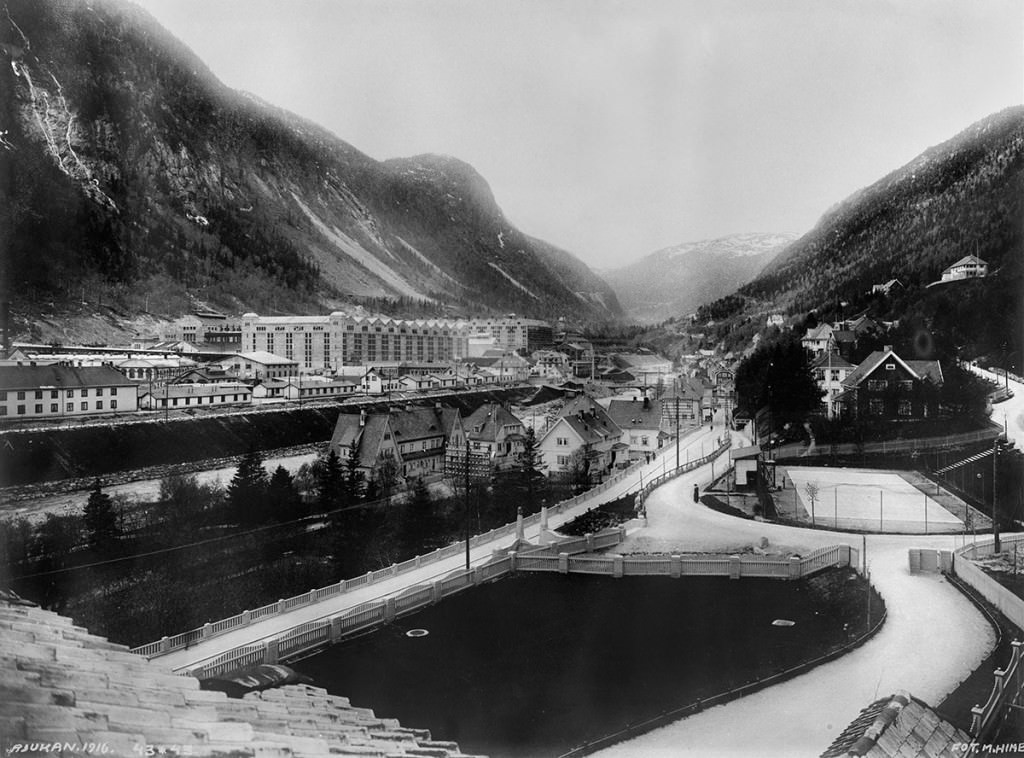
5. The Heavy Water war

The struggle to develop the atomic bomb
During the Second World War, several attempts were made by the Allies to prevent Nazi Germany from developing an atomic bomb. The production of heavy water at Vemork was crucial here.
The most famous sabotage raid, codenamed Operation Gunnerside, was mounted by a small team of specially trained Norwegians, some of whom had local knowledge. They blew up the heavy water cells, although not a shot was fired during the action.
The route by which the nine saboteurs entered the plant unseen, and afterwards fled towards the Hardanger plateau, crosses the river gorge below the power plant. It is now called the saboteurs’ trail.
The other actions designed to disrupt production and prevent the transport of heavy water, were codenamed Grouse and Freshman. Then there was the sabotage action mounted against the ferry Hydro on Lake Tinnsjø. The destruction of the ferry claimed the lives of four Germans and 14 Norwegians.
«Jakten på tungtvannskjelleren» er et prosjekt der nettopp kjelleren som var målet for operasjon Gunnerside skal graves fram.
Hydrogenfabrikken på Vemork ble tatt ut av drift tidlig på 1970-tallet da Hydro bygde nytt kraftverk inne i fjellet bak Gamle Vemork kraftverk. I 1977 ble fabrikken revet, slik at det gamle kraftverket igjen ble synlig. Restene av hydrogenfabrikken ble pakket ned under et flere meter tykt lag med jord, stein og bygningsmasser.
Joachim Rønneberg, som ledet sabotasjen mot tungtvannsanlegget, har flere ganger gitt uttrykk for at stedet hvor aksjonen fant sted, bør gjøres tilgjengelig for formidling. Høsten 2017 igangsatte Telemark fylkeskommune omfattende utgraving for å avdekke kjellerlokalene hvor det ble produsert tungtvann. Det var ventet å finne rester etter kjelleren, men utgravingen viste at kjelleren er tilnærmet intakt. Det er mer enn hva de fleste våget å håpe på.
NRK-serien Kampen om Tungtvannet gikk sin seiersgang på TV vinteren 2015. Serien skapte stor interesse for krigshistorien knyttet til tungtvannsaksjonene. Siden er serien blitt vist i flere land, som i sin tur har gitt stor oppmerksomhet internasjonalt og økende pågang av besøkende turister.
Etter fullført utgraving og sikring skal det reises et museumsbygg over de fremgravde bygningselementene. Dette skal sikre og ta vare på kulturminnet, og skape et areal for utstilling og formidling.
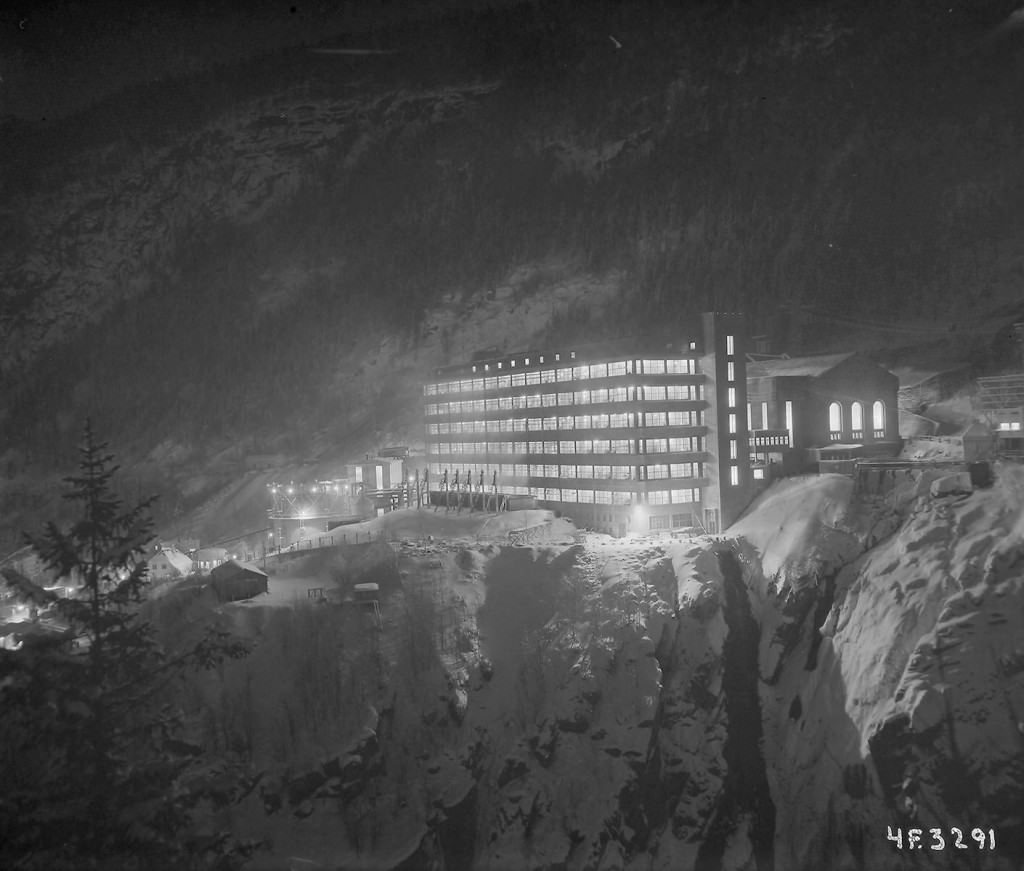
After it had been decided to stop the production of heavy water, a final shipment was to be made from Vemork to Germany. This transport was sabotaged on orders from the Allies in London.
Major Knut Haukelid, one of the original saboteurs, was informed by London that there were plans to ship the remaining semi-finished product to Germany. Via radio transmission he was ordered to destroy this shipment.
The weakest link in the transportation was considered to be the railway-ferry crossing of Lake Tinnsjø. A team drawn from the Gunnerside raiders were given the task, and they deemed it to be most effective to sink the ferry while on the lake. It was Knut Haukelid and two others who were to carry out the action. On Sunday February 20 1944 DF Hydro carried passengers, some tank and goods wagons, and two wagons containing 14 tonnes electrolyte, the equivalent of 600 kg heavy water.
The sabotage team managed to sneak on board the ferry the night before and place explosives under the deck. An alarm clock was set to ignite the explosives, which went off in the middle of the lake. 18 lives were lost and 26 were saved. This was the final chapter in the struggle for heavy water in Norway. More people would have died had the explosion taken place on a weekday; on Sundays there were generally fewer passengers.
DF Hydro, which lies at a depth of 430 metres off Rudsgrend, is one of the significant objects of the Rjukan-Notodden World Heritage.
6. The transportation line

People, materials and industrial products on the move
In order to build power stations and run industries at Rjukan it was necessary to construct a railway line from Notodden. Transport over Lake Tinnsjø was by means of rail ferries. And in the early years the canal link to Skien was absolutely crucial.
From Rjukan the train ran to Mæl, from where there was a ferry link over Lake Tinnsjø. Then the train proceeded to Notodden where another transhipment took place to a boat that navigated the Telemark canal down to Skien and Menstad. From 1917 onwards this stretch could also be negotiated by rail with the advent of the Bratsberg line.
The ferries S/F Ammonia and M/F Storegut, which have been preserved and are now listed, are located at Lake Tinnsjø. They are absolutely worth a visit; and you can also embark on a lake cruise on board M/F Storegut.
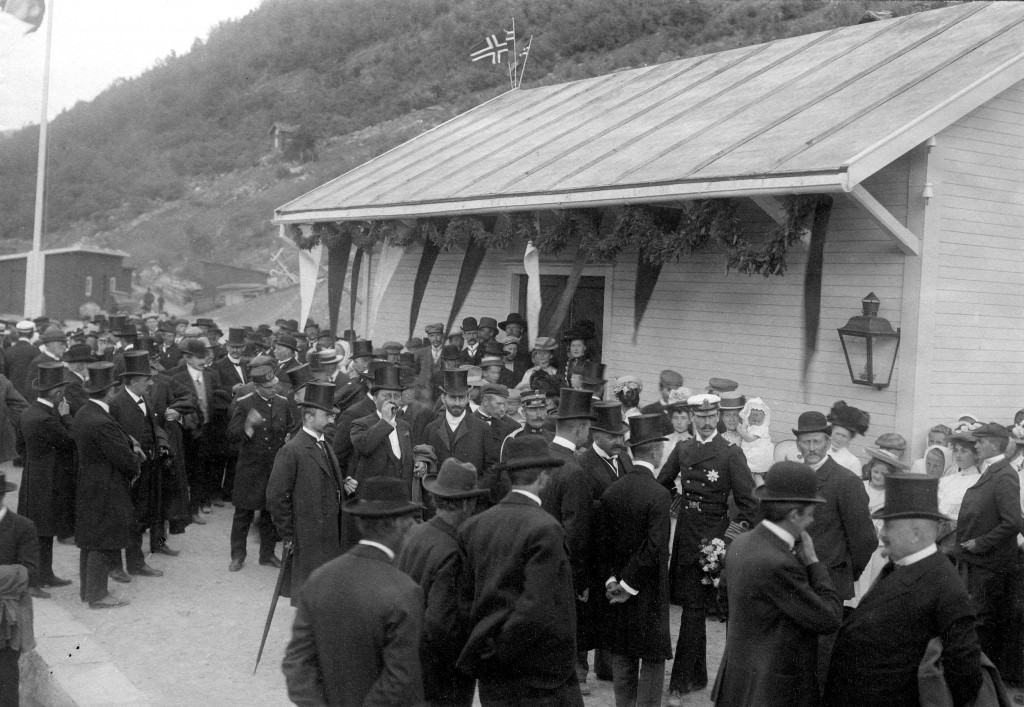
The Rjukan line was opened by King Haakon VII in 1909. The railway was in constant operation between 1909 and 1991, carrying an impressive 30 million tonnes of freight.
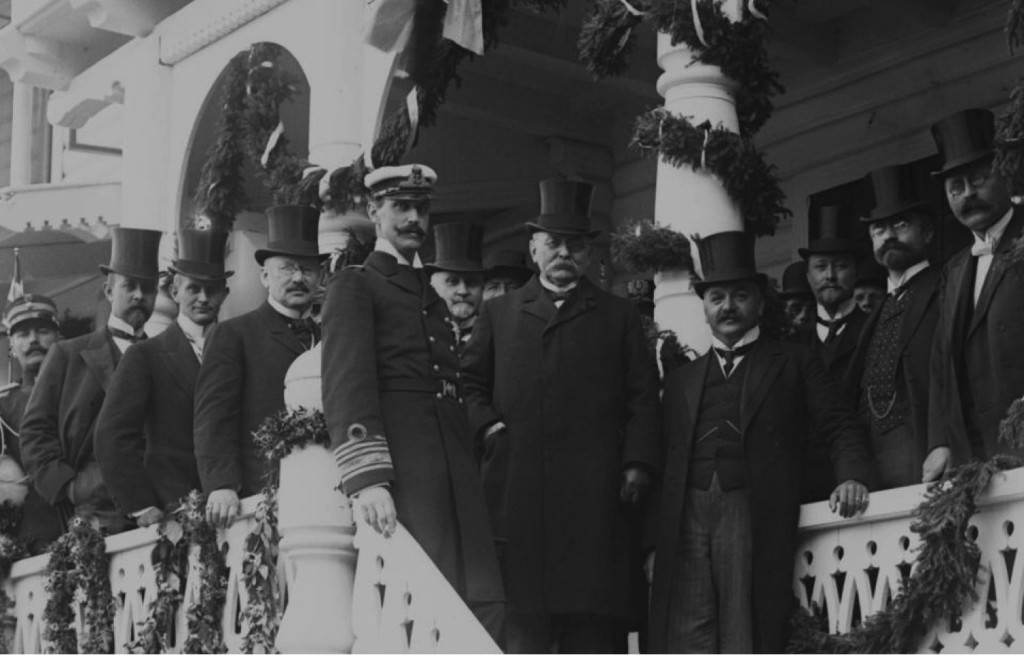
Tinnoset station, which is constructed of cog-jointed round timber that reflects the traditional rural building technique of Telemark, is unique within Norway railway architecture. It was designed by architect Thorvald Astrup, who was also responsible for the Admini at Rjukan and one of the architects who designed Såheim power station. Astrup was one of the architects most frequently employed by Hydro at Rjukan and Notodden. Several of the buildings he designed for Hydro are situated on Herøya at Porsgrunn.
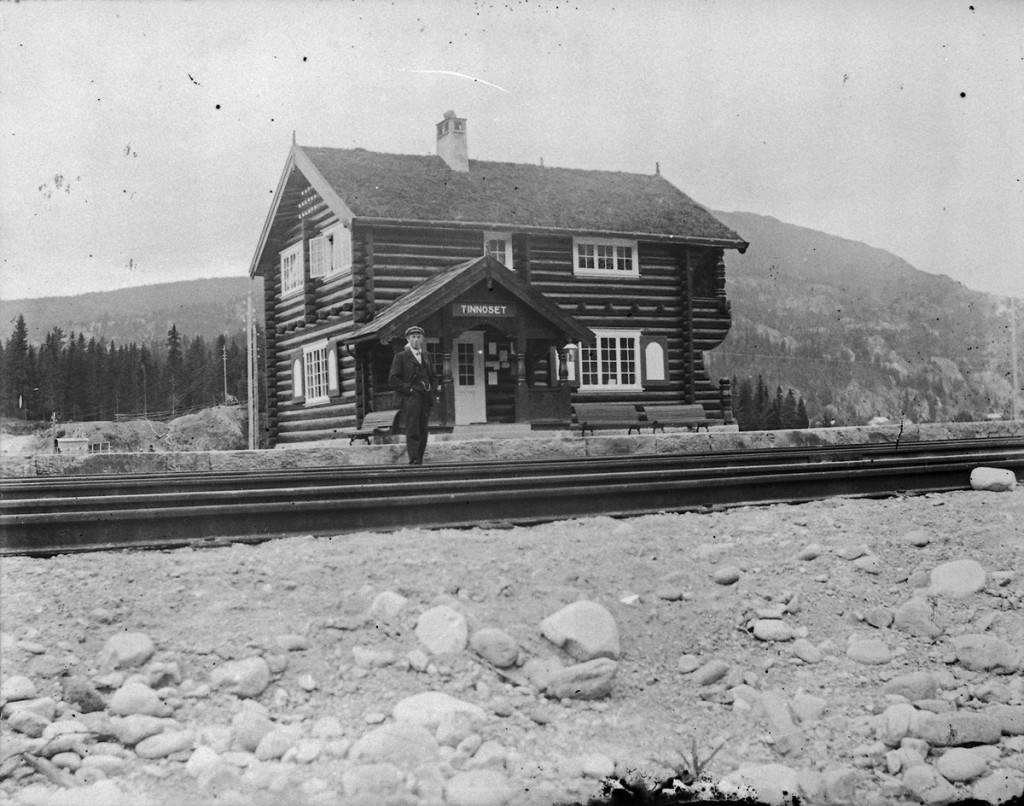
Before the railway was built, horses carried goods, people and equipment. They literally pulled the entire load. As many as 100 horses were put to work on each of the routes, all year round and in all kinds of weather. 1000 hungry workers needed their daily bread and the nearest bakery was at Notodden. Maybe it is not so strange that the rail project proceeded at a record pace?
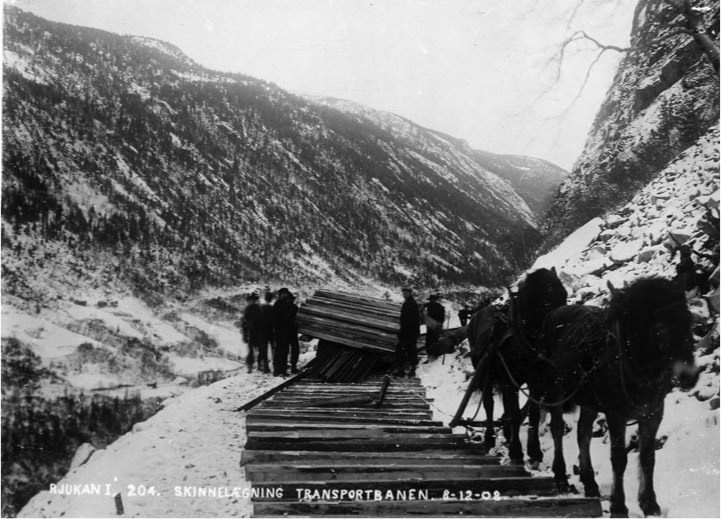
The steep and rugged terrain between Notodden and Rjukan/Vemork make this stretch one of the most ambitious transport construction projects from early Norwegian industrial history. The gradient on the more than four-kilometre-long route is 57 metres for every kilometre of track.
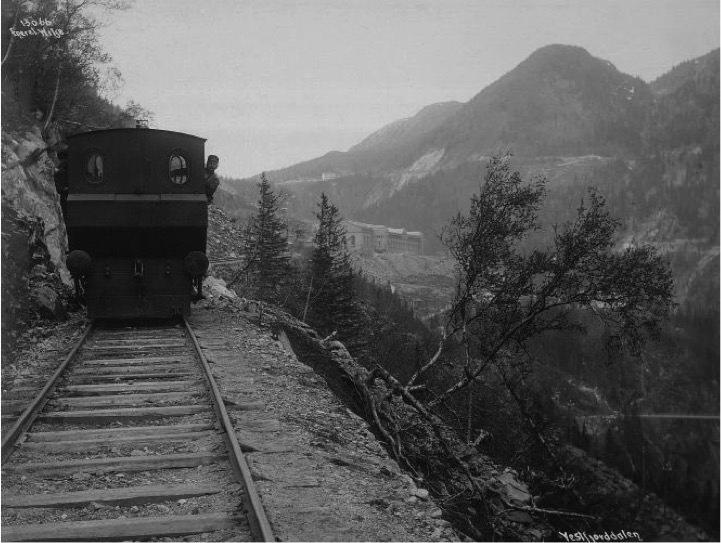
Of all the vessels that have plied the route over Lake Tinnsjø just two have survived: Storegut and Ammonia. But they are the proud swans of the lake, and both ships are now protected.
The first rail ferry was built at the same time as the ferry berths were constructed at both ends of Lake Tinnsjø. The vessel Tinnsjø was timber-built and did not have an engine, so it had to be towed by the icebreaker SS Skarsfos that was launched in February 1908. Tinnsjø was in use right up until 1929 for the transport of quartz from the quarry at Busnes, among other cargoes. D/S Skarsfos has now been converted and is used for passenger traffic from Skien.
After Tinnsjø, the vessel S/F Rjukanfos came into operation in 1909, S/F Hydro in 1914, and S/F Ammonia, the last of the steamships, in 1929. S/F Ammonia was built at the same time as the plants were converted to the Haber-Bosch method of production.
With the loss of S/F Hydro during the second world war, the fleet’s capacity was insufficient. S/F Rjukanfos was extended, but the result did not live up to expectations. The ship was difficult to manoeuvre and was broken up in 1969, by which time M/F Storegut had already been in operation for 13 years. M/F Storegut was in fact completed on the slip at Tinnoset. Both S/F Ammonia and M/F Storegut are listed. Since 2017 M/F Storegut has been certified to carry up to 249 persons and currently operates a tourist route during the summer.
One of few
S/F Ammonia is a double-screw railway ferry of riveted steel built by A/S Moss Verft og Dokk and assembled on a temporary bedding at Tinnoset. She is 230.6 ft long, 35.2 ft wide and has a draught of 12.8 ft. She has a gross tonnage of 929.34 and a net tonnage of 339.14. With 120 metres of track on board, she has room for 16–17 railway wagons. She can carry deck loads of up to 630 tonnes, and can accommodate 250 passengers as well. Two 450 hp triple expansion steam engines are used for propulsion, and she has cruising speed of 12 knots. She is one of the few remaining vessels of her kind in the world, and probably the best preserved.
Biggest in the Nordic countries
M/F Storegut is the biggest inland vessel in the Nordic countries. She is a steel-hulled, triple-screw railway ferry built by Glommens Mekaniske Verksted. The wheel house is made of aluminium. She is 82.11 metres long, 11.31 metres wide and has a draught of 3.75 metres. She has a gross registered tonnage of 1119. With 156 metres of track she can carry approx. 19 railway wagons. Her maximum deck load is 800 tonnes. In addition, she can carry 400 passengers. Three six-cylinder four-stroke diesel engines from Motoren Werke Mannheim are used for propulsion, each with an output of 750 hp. Cruising speed is 13–14 knot with two engines running, and she can attain 18.5 knots when using all three engines. The ferry was the first vessel in Norway to be equipped with bow thrusters.
S/F Ammonia and M/F Storegut were, along with the ferry berths, slipways, beacons, railway materiel, rail tracks and buildings, transferred from Hydro to Stiftelsen Rjukanbanen (The Rjukan railway line foundation) in 1997. From 2013 onwards the installation was transferred to the Norwegian Industrial Workers Museum (NIA). The ferry berth at Tinnoset, including associated buildings and Tinnoset slip, are also now the responsibility of NIA when it comes to repair and maintenance.
Of the installations at Tinnoset, there are grounds for making special mention of the slipway and the ferry berth. The slipway lies just east of the berth. The first slipway was 110 metres long and had a gradient of 1:10.
The slipway is made of hand-riveted iron and includes, among other things, a slipway wagon, stay bars, a rolling frame, rails, wooden keel blocks (pads) and four inspection towers. The slipway has a 161-metre-long rolling track that runs into the lake at a gradient of 1:12. The slipway rests on wooden sleepers and concrete pillars, and has a new concrete foundation next to the winch house. The rolling track holds an approximately 113-meter-long rolling frame with an approximately 76-metre-long slipway wagon on top. These are pulled along the rolling track by a winch-operated wire rope. There is also an auxiliary compressed air winch. The slipway’s design and position dates from around 1915.
A new winch house was built 19 metres further inland in 1914. The current winch house stands on a cast concrete base and is built of polished brick. By an iron gateway and concrete ramp stands a hand-riveted round air tank (for the compressor) that is attached to the wall by a metal bar and from which a pipeline is led into the building.
The winch house consists of three main rooms with a compressor to the south, machine shop in the middle, and a machine room furthest to the north of the building. The machine room contains, among other things, electrically driven drums with wire rope and cogwheel. The current winch house was built in 1937 after the previous one, dating from 1914, burned down after being struck by lightning.
With the increase of traffic on Lake Tinnsjø from 1929, Tinnoset became the main hub in the municipality of Gransherad, as it then was, with a hotel, post office and three shops.
Trains and ferries came and departed at least five times daily, and there could be hundreds of passengers, especially on public holidays and during vacation periods. Tinnoset was also popular with people who liked to pick berries or go fishing.
Fishing took place below the dam and out on the ice on Lake Tinnsjø. Char were known to swim in shoals in the wake of the ferry, so the ice fishers were keen to obtain a good spot close to the open channel. But this was not without its risks; waves might break the ice into floes, and for the ferry’s captain encroaching ice fishermen could be a real nuisance. Altering the ferry’s course did not leave much room for error.
Safety regulations were less stringent in days gone by. Tank wagons containing ammonia could fill the upper deck, whilst the lower deck was packed with all kinds of passengers. It goes without saying that such a lively location also became a natural meeting place for the young people of the town. A simple shelter had been erected between the station and the ferry berth, and the youngsters tended to gather here. “When’s the next train due?” They knew when. They also knew if the train was on time…well, they nearly always knew.
Tinnoset has had its incidents, and some of them have been dramatic. The winch house used to pull the ferry up onto the slipway was once struck by lightning; the wire rope snapped and the slip wagon careered into the water, where it broke in two. Major repairs were needed, but the heaviest task – that of hauling the wagon back on land again – was solved with the help of S/F Ammonia and a crane on board.
7. Notodden

The birthplace of the adventure
Notodden was the birthplace of the world’s first successful industrial production of fertilizer. To begin with it was the Tinfos I power station, and later Svelgfoss, which provided the energy necessary for the production of mineral fertilizer using the electric arc furnace and the Birkeland-Eyde process.
Today the Hydro industrial park, which is listed, represents an important industrial artefact.
In pace with the development of industry in the area, an entirely new urban community was formed. The first dwellings built by Hydro were at Svelgfoss, followed by housing projects such as Villamoen, Egne hjem and Grønnbyen. Towering above Grønnbyen, and overlooking the factory area, is the Admini, the listed administration headquarters where Sam Eyde lived, worked and received important guests. A visit to the Admini could be a morale booster, according to Eyde. As he put it in his memoirs: “When the going got tough and there was a tendency to pessimism, I often gathered my colleagues here for a little party; it is incredible how comradeship and trust can inspire new hope and impart new strength”.
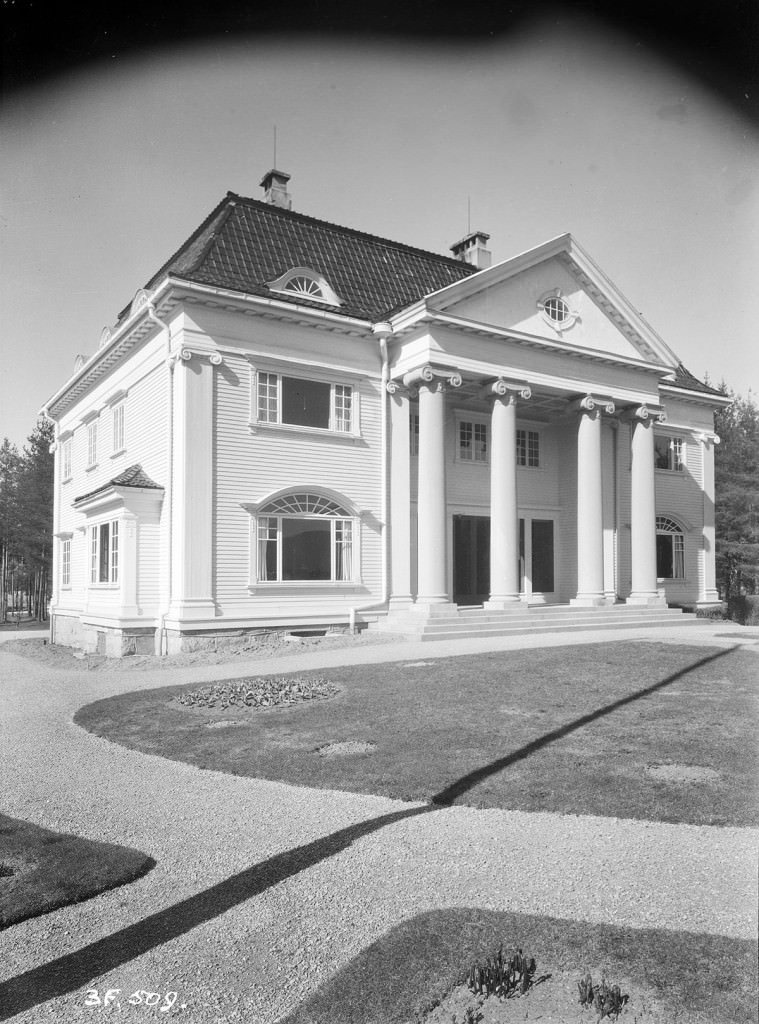
Building the administrative headquarters, or Admini, at Notodden in 1906 was a carefully deliberated move. It was here that Hydro would be able to receive all sorts of guests from far and near.
The Admini was also used for hospitality purposes, for accommodating important visitors and as Sam Eyde’s Notodden residence. For the first 55 years of Hydro’s history it went without saying that the company’s annual general meeting was held here. The Admini towers over Grønnbyen, overlooking the factory area.
Much of the building’s interior was created by the wood carver John Borgersen, who won a gold medal at the world exhibition in Paris in 1900, and also made furniture for Kaiser Wilhelm II.
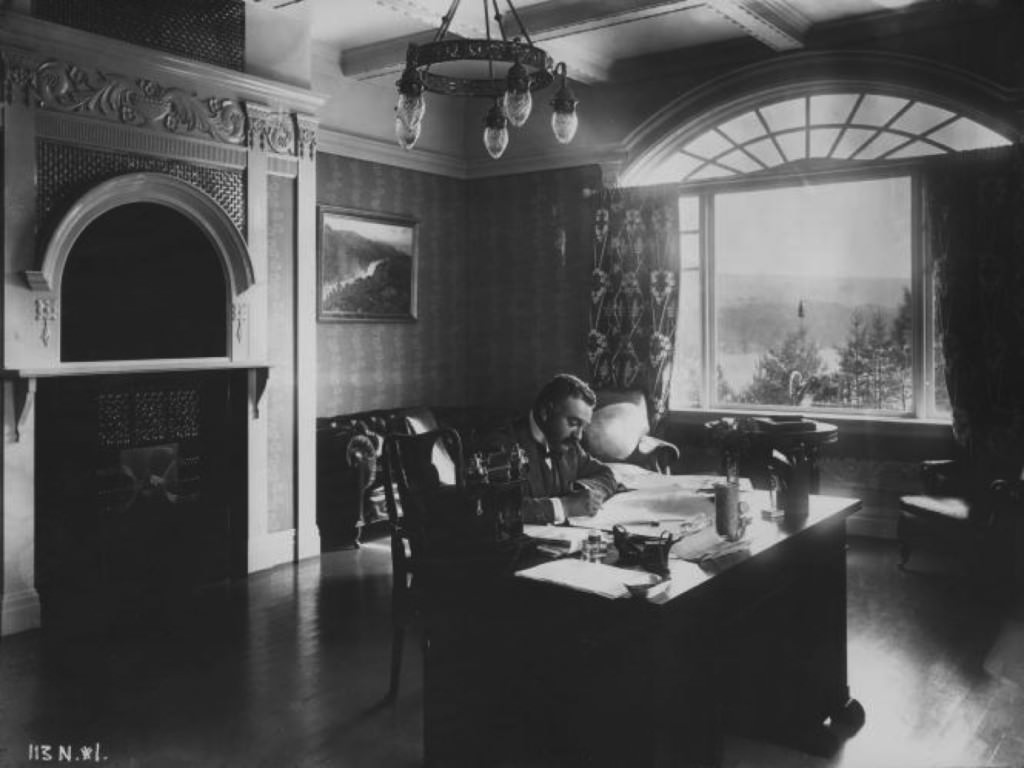
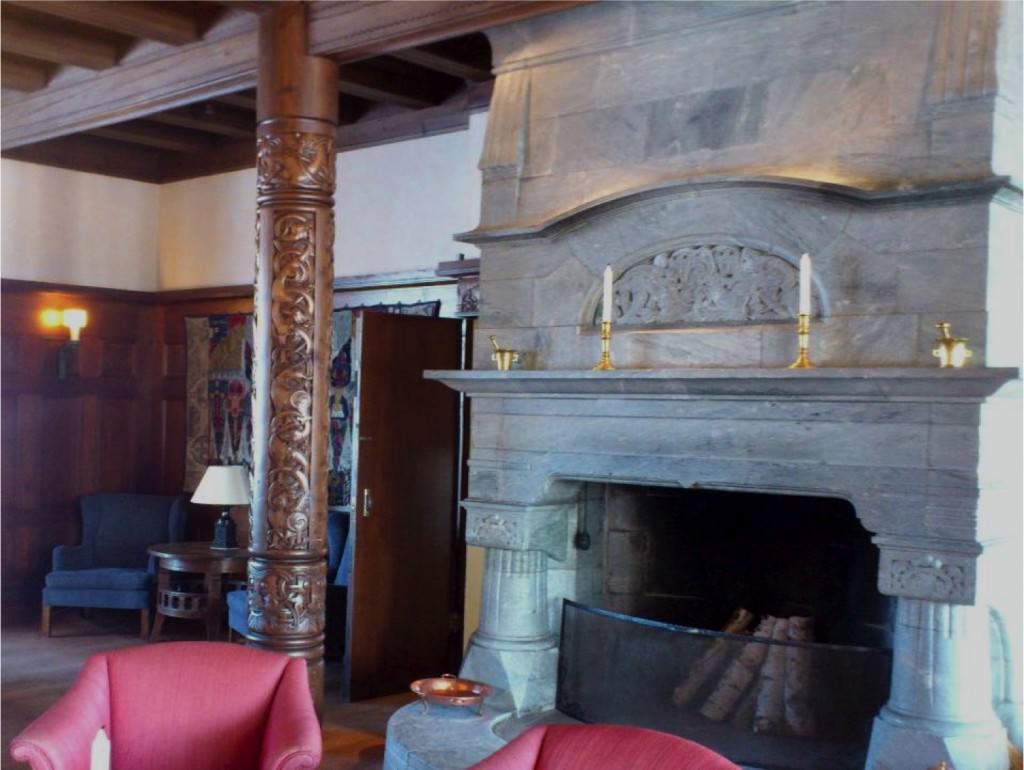
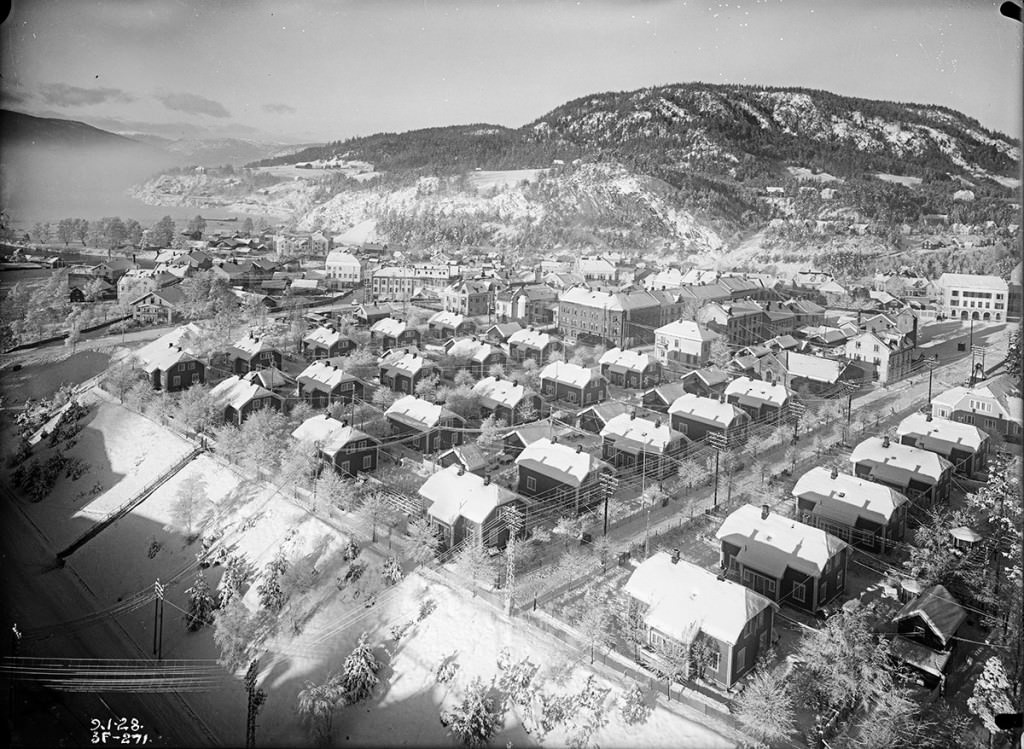
The interrelationship between the factory, the workers’ houses and the administrative headquarters is typical for early phase of industrialisation, on terms of both the appearance of the buildings and their location.
There is a clearly discernible structure in the landscape and buildings appearing during Hydro’s initial phase at Notodden. The buildings at Villamoen, for example, were erected between 1908 and 1918 – a planned structure comprising 17 dwellings, situated behind the Admini.
Villamoen rests on a terrace overlooking Grønnbyen and was for that reason considered suitable for the houses of the salaried staff and engineers, who ranked higher than the factory workers. Their houses were therefore of a more individual character, in the design of which several architects were involved. The houses were originally painted white and reveal aspects of various contemporary styles: art nouveau, neo-baroque and classicism.
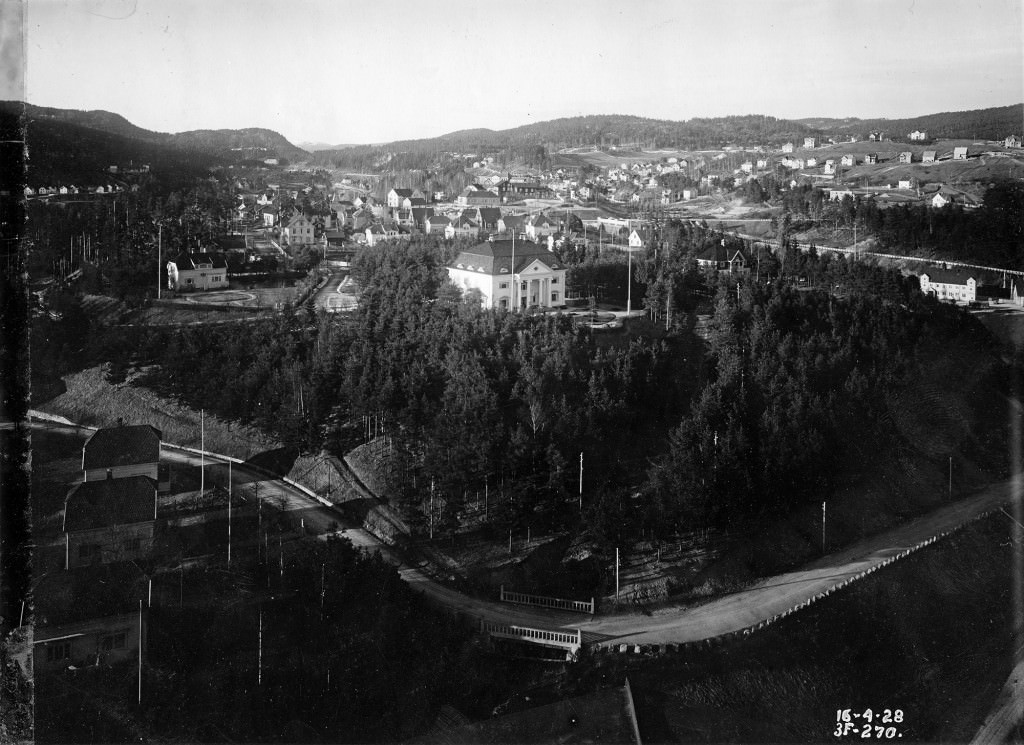
Theodor Kittelsen, inspired by the Rjukanfoss waterfall and the development of industry based on hydroelectric power at Notodden, painted five famous watercolours. Sam Eyde commissioned Kittelsen and also put forward several suggestions regarding the shape and form of the pictures. You can view the paintings themselves, and the sketches, at Telemarksgalleriet in Notodden.
Eyde wanted the workers and the forces of nature to be given their share of the credit for momentous developments taking place. In his memoirs (1939) he writes: “Kittelsen painted at that time some paintings that showed what he felt. A more beautiful and more humorous tribute to my work I have never received”. By November 1907 all the details were in place and the paintings were delivered in May 1908.
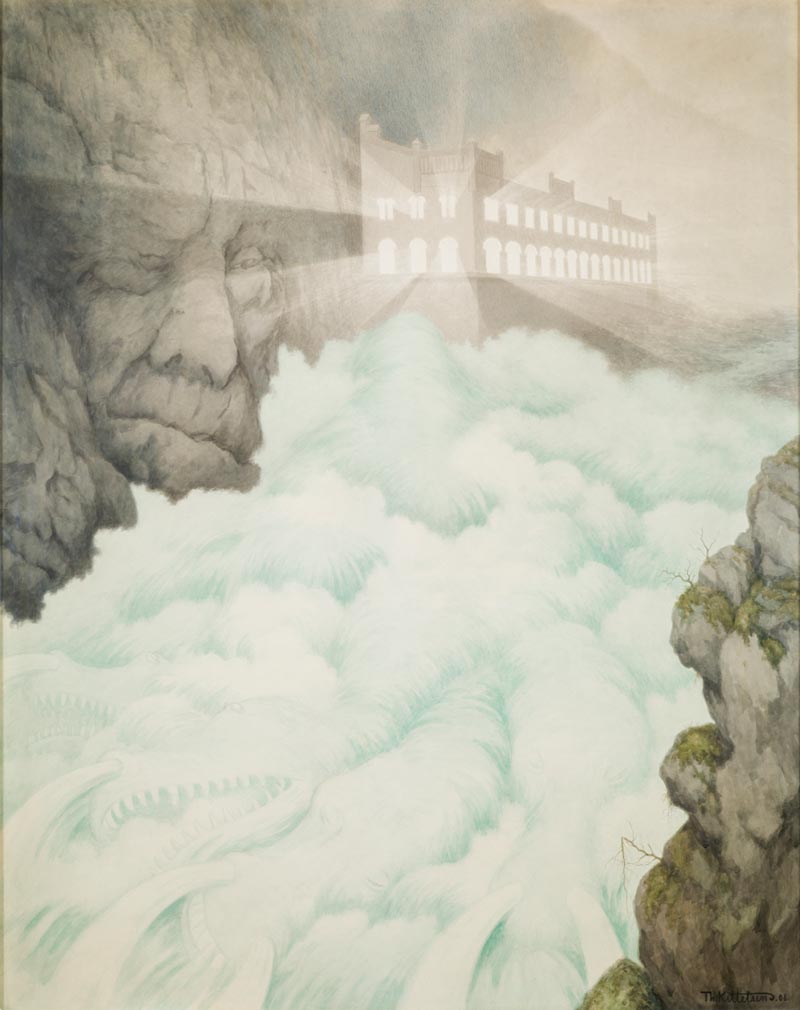
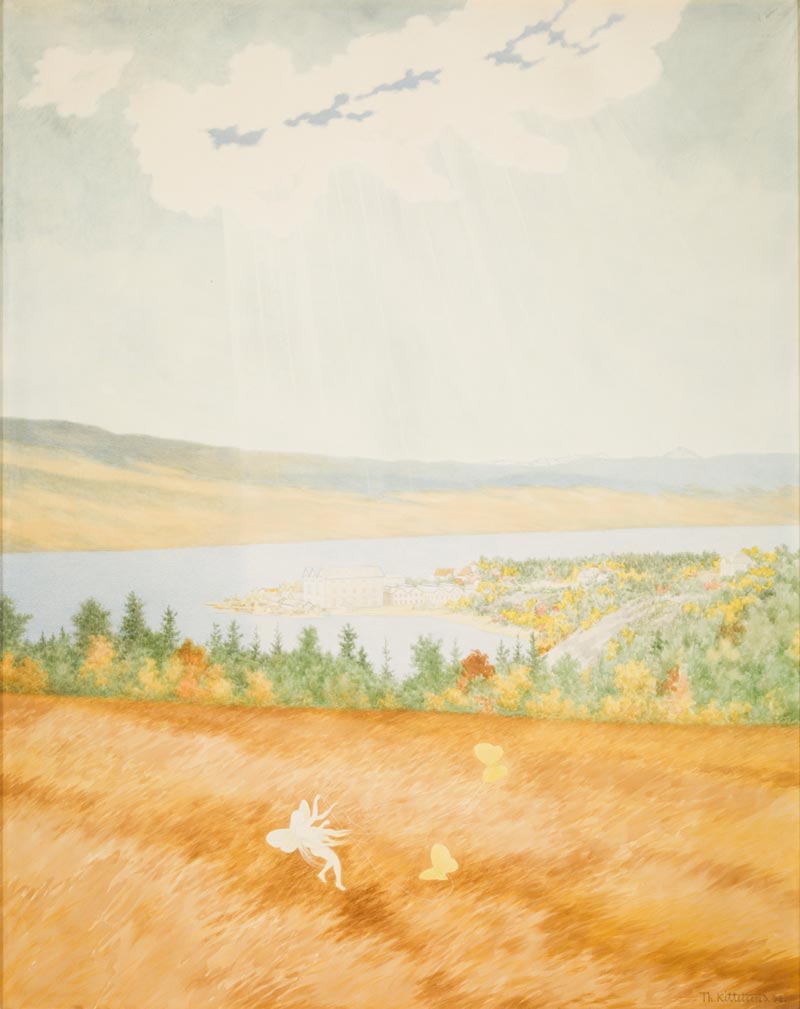
Kristian Birkeland is one of Norway’s leading scientists throughout history, and one of Hydro’s founders.
Birkeland (1867-1917) was born in Kristiania and was made professor of Physics in 1898. His main interest was in astrophysics – polar lights, solar radiation and the earth’s magnetic field.
Birkeland obtained nearly 60 patents in the course of a roughly 10-year period; many of them were sold, many were never realised. In 1901 he was granted a patent for an electromagnetic cannon. He applied the principles of the cannon in developing the electric arc furnace.
Professor Birkeland was made a lifelong technical consultant to Hydro at the company’s annual general meeting in 1905. This position enabled him to pursue his research interests more thoroughly.
Birkeland identified a connection between the northern lights and activity on the sun’s surface. He supported his theory by conducting practical trials in the laboratory at the University of Kristiania, and he undertook some very demanding and expeditions and study tours to northern regions.
Birkeland died in Tokyo on June 15 1917, as preparations were in underway in Norway for the celebration of his 50th birthday. An initiative had also been taken – for the seventh time – to secure for him a Nobel prize in physics or Chemistry. Though he was never awarded a Nobel prize, Birkeland’s theories were confirmed and form the basis for our current scientific knowledge in the area.

Notodden’s inhabitants had to put up with the fact that the newspapers described the factories more positively than the town itself. The urban community suffered from growing pains that would take years and even decades to heal. The industrialists did get involved and provided some support, but they also left much for the municipality to take care of.
” Notodden is a Nordic Klondike. Mushroom-like, it has grown very rapidly and is therefore still too unsettled to be considered a proper town”, wrote the newspaper Socialdemokraten on December 5 1908.
Housewives are said to have washed their clothes in in the river Tinn and the Hvalå brook. Construction of a waterworks commenced in 1910, but progress here was slow. There was no plan for street regulation and this hindered the development of the water supply and drainage project. The streets were often in a deplorable state during the spring and winter, and dust whirled all around in summer.
The public services were doomed to struggle to keep pace with the all too rapid urban growth. In 1910 only 1 per cent of the inhabitants of the town was over 70 years of age; and even though many women did move into the area, in the same year they comprised no more than 40 per cent of the total population.
The population consisted of a diverse mixture of people. One thing was that they came from all types of places, from both urban and rural areas; another was that these new inhabitants assumed some very different roles in local society. As a rule, workers’ families found it a struggle to make ends meet. Things improved when several family members found work, while most of those who had their own house took in a lodger as well.
A rural community that was rich in tradition, in which also teachers had begun to be trained in 1896, provided a solid basis for cultural and other leisure time activities. Many of the incomers were keen to form associations and engage in the activities they had pursued prior to moving. There soon emerged a whole host of associations for song and music, scouting, sports, both summer and winter variants; as well as language groups promoting nynorsk, political parties, and evangelical associations and chapels. These associations helped bind the community together. And to some extent, but not always, they also helped bridge the gaps arising from the rigid class differences that separated people according to job or family background.
8. UNESCO

World heritage in Norway
“Since wars begin in the minds of men, it is in the minds of men that the defences of peace must be constructed”.
UNESCO, the United Nations Educational, Scientific and Cultural Organization, was founded in 1945 and is headquartered in Paris.
- UNESCO’s aim is to build peace through international cooperation in the above areas.
- Norway became a member in 1946.
- UNESCO currently has 195 permanent and 10 associated members.
UNESCO’s world heritage convention was adopted in 1972 with the intention of conserving natural and cultural objects of irreplaceable value for all of mankind – for current and future generations. The convention is UNESCO’s greatest success, and has been ratified by more independent nations of the world than any other convention. Its success is to a great extent due to its List of the World’s Cultural and Natural Heritage sites, into which the first objects were inscribed in 1978. There are currently more than 1,000 objects from all corners of the world on the list.
UNESCO’s World Heritage List includes cultural artefacts and milieux, as well as natural areas of outstanding universal value (OUV) from an historical, artistic, scientific or aesthetic viewpoint.
-
- Integrity
- Authenticity
- Long-term protection
- Sound management
- Local backing for World Heritage concept
When the Second World War ended, the people of the world welcomed the return to peace; but it was a peace fraught with uncertainty, and reconstruction took place in a divided world. It was during this period that the United Nations organisation and a number of UN agencies emerged, among them UNESCO – the organisation for education, science, culture and communication – which was founded in Paris on November 16 1945.
UNESCO’s overarching objective was to help promote peace and security through international cooperation in these areas. This aim is encapsulated in the following citation: “Since wars begin in the minds of men, it is in the minds of men that the defences of peace must be constructed”.
When UNESCO’s World Heritage Convention was adopted in 1972, it was the first international agreement to officially recognise the relationship between the cultural and the natural environments as being equally important for people’s lives and welfare. It clearly challenged all countries to protect and conserve their cultural artefacts of both local and national significance. UNESCO regards the World Heritage Convention to be the most successful of its conventions – a” flagship for UNESCO’s programme”. It has been ratified by more than 190 countries, which is more than other convention.
The World Heritage Convention came into being at a time when the world’s population had experienced and survived some almost catastrophic events such as the Cuban missile crisis. The so-called balance of terror held sway. However – a quarter of a century after the Second World War – other challenges emerged that required determined and concerted efforts to tackle. The most serious of these was the effect that wear and tear and human impact was having on the environment.
Progress had also been made in terms of finding ways and means to preserve the cultural treasures of the world’s civilisations. The international Venice Charter for the conservation and restauration of cultural artefacts had been adopted in 1964, but it had in fact been preceded by an earlier achievement, the Athens Declaration of 1931.
One specific example that could point the way forward was the international action coordinated by UNESCO to save the Abu Simbel temple in Upper Egypt. National liberation movements were playing a greater role in many countries, and Egypt became a focal area during the 1950s due to the national liberation movement and rivalry between the super powers. The Suez Canal and Aswan Dam conflicts were part of the overall picture here.
The action to save the temple continued for four years until 1968. The temple was dismantled, sawn into pieces weighing between 30 and 50 tonnes, moved and rebuilt again 65 metres higher and 200 metres away from the river bank. No fewer than countries took part, including Norway. Had they not done so the temple would have been lost as a result of the construction of the Aswan Dam in the south of Egypt. This salvage action was considered to be a success; an expression both of UNESCO’s overarching role and of the necessity for international cooperation to preserve mankind’s irreplaceable cultural heritage.
When the Rjukan-Notodden industrial complex was inscribed on UNESCO’s World Heritage List in 2015, it was the eighth inscription for which Norway is responsible for protecting, preserving and managing.
The first four Norwegian World Heritage sites are cultural sites that were inscribed between 1979 and 1981. More than 20 years later – in 2004 – Norway had its first cultural landscape inscribed on the list – the Vega Archipelago in Nordland. The following year the West Norwegian Fjords were inscribed, the first natural area in Norway to attain this recognition. In the same year the Struve Geodetic Arc – a transnational serial site nomination – inscribed.
Here we will briefly present the seven other sites in Norway that have so far been inscribed on the World Heritage List:
- Urnes Stave Church (1979)
- Bryggen in Bergen (1979)
- Røros Mining Town and Circumference (1980)
- Rock Art of Alta (1985)
- Vega Archipelago (2004)
- West Norwegian Fjords – Geirangerfjord and Nærøyfjord (2005)
- Struve Geodetic Arc – four points in Norway (2005)
Rjukan-Notodden Industrial Heritage Site (2015)
In terms of its architecture, its art, as an historical artefact and as a source of knowledge, Urnes stave church is unique among the 28 remaining stave churches in Norway. It was erected employing the most advanced construction technique for wooden buildings to be found in Northern Europe from the Stone Age to the Middle Ages. Urnes stave church was built in the second half of the 12th century and is an example of first-class craftmanship. It has a richly decorated interior and contains some particularly fine wood carvings.
Both the general decor and wood carvings reveal examples of Celtic, Norse and Romanesque traditions. The church stands in a magnificent fjord landscape in the Lustrafjord, a branch of the Sognefjord. Urnes stave church was previously a private place of worship for a powerful family in the area.
In the Middle Ages Bryggen, the old wharf in Bergen, was a lively centre for international trade. The characteristic, harbourside rows of houses with gabled facades exemplify an architectural style that has existed for nearly 900 years. This traditional timber-based architecture demonstrates that Bergen is one of the oldest trading centres in Northern Europe. Bryggen is the only trading town outside the Hanseatic League of which the original structure has been preserved within the centre of the town.
The houses on Bryggen were built in parallel rows at right angles to the quayside, on one or two sides of a shared passageway between the buildings. The houses contained dwellings, offices and the store rooms required by the international stockfish trade, and the original function of Bryggen continued until the 1900s.
The wooden buildings, as they currently appear, were erected after the fire of 1702. Following the fires of 1955 and 1958, roughly one quarter of the original buildings are still intact.
Bergkunsten i Alta, Finnmark gir innsikt i menneskers liv og verdensoppfatning i tidligere tider. De første helleristninger og hellemalerier ble funnet i 1973. Siden har figurer blitt avdekket på fem forskjellige steder i dette området. Mer enn 3000 figurer som ligger mellom 9 og 27 meter over dagens middelvannstand, danner det største antall figurer i Nord-Europa.
På grunn av landhøyningen kan ristningene inndeles i faser over et tidsspenn på mer enn 4000 år (fra 4000 før vår tidsregning til år 0). De gir dermed en nøkkel til kronologien innen ristninger i resten av Skandinavia. Motivene viser at det har vært kontakt mellom bosetting i Alta og områder i øst og sør. Enkelte figurer og de fleste sammensatte scener er enestående med sine jakt- og fangstmotiver.
This cluster of islands, cantered on Vega, is situated off the Helgeland coast in Nordland county, where fishing has been a way of life for the last 10 000 years. As the first islands were gradually inhabited, the characteristic landscape came to be formed through the interaction of the fishermen farmers with their harsh but rich natural surroundings. The 1037 square kilometre cultural landscape takes in islands, islets, skerries and the sea. The Vega archipelago consists of fifteen fishing villages where a total of 59 islands have been inhabited.
It has been documented that eider down farming was practised here from as early as the end of the 9th century, and the harvesting of eggs and down from wild eider ducks has remained up until today an important occupation on the Helgeland coast. In fact, down collection for quiIt production is a tradition that is still maintained on several islands within the world heritage area. Women have largely been responsible for pursuing this trade, and by inscribing Vega on the world heritage list, their efforts over the centuries have been given due recognition.
Mining and agriculture formed the basis for emergence of the town of Røros in Trøndelag. This is also seen in its design structure, which reflects the technological and industrial development of the town. Traditional building techniques reveal how both mining and farming provided the inhabitants with their livelihood.
The appearance of the town is due both to local building traditions and to the impulses from abroad which arrived as a result of the development and operation of the copper mines from 1644 until 1977. Røros’ world heritage status was expanded in 2010, when the area surrounding the mining town, the circumference, was added to the World Heritage List.
The West Norwegian Fjords world heritage consists of Geirangerfjord in Møre and Romsdal and Nærøyfjord in Sogn and Fjordane. These two spectacular regions, which are situated 120 km from each other, are examples of classical fjord landscapes in a geological sense, as they demonstrate the development of the landscape from the end of the Ice Age until today.
There are traces in the landscape that reveal the fjords to have been utilised by man ever since the ice receded 10 000 years ago. We find farms on the small patches of land alongside the fjords, and mountain farms perched on ledges high above the fjord. These settlements testify to the painstaking agriculture that has been adapted here in the rich but hazardous natural surroundings. Beyond tightly-knit little villages there are few indications of human or technical impact. Geirangerfjord and Nærøyfjord are the two largest unspoilt fjord landscapes in Norway.
The Struve arc was the first large-scale scientific measurement undertaken in Europe. It was carried out between 1816 and 1852 by the astronomer Friedrich Georg Wilhelm Struve. The arc is outstanding in terms of scope and quality, and represents an important element in the history of geoscience.
The Struve arc was measured by a chain of survey triangulations stretching from Hammerfest to the Black Sea. Four of the points are located in Finnmark. The entire chain passed through ten countries: Norway, Sweden, Finland, Russia, Estonia, Latvia, Lithuania, Belorussia, Moldova and Ukraine. The survey measurement was in use for more than a century until it became possible to conduct astronomical and satellite-based precision measurements. Struve’s geodetic arc is the first transnational addition encompassing more than two countries to be inscribed on the Worlds Heritage List.


